Social media can be a hard nut to crack. You’re competing in a crowded space right alongside the biggest brands. But you never know when your newest idea might catch fire and become a social media sensation. We’ve rounded up 10 of the best social media campaign ideas to inspire you while you’re thinking of the next big thing.
Related: How to achieve brand consistency on social media
1. Show your product in action: Nest Cam
Google+ is sometimes left out of the social media circle, but that means you have the opportunity to become a stand-out brand on the platform. Nest, a company that produces advanced thermostats, smoke alarms, and home security cameras, has an enviable Google+ page that can be an example for your brand. Their page in general has a well-branded and visually appealing aesthetic, but one recurring feature is particularly delightful: the #caughtonNestcam videos (Nest Cam is Nest’s home security camera). This one is pretty good:
Here, Nest succeeds in showing their product in action in an engaging and humorous way. Seeing the Nest Cam in a real person’s home makes it easier for a potential customer to picture it in their home. It seems like Nest’s efforts are paying off, too. They have over 12 million Google+ page views and 604k followers.
2. Try a new platform: Oreo + Vines
Have you considered Vine as a social media marketing tool? It’s not the first platform that typically comes to mind, but Vine is a jungle of opportunity (get it?). Oreo caught the Vine vision and used the platform to make videos that, well, made people want to eat more Oreos. These videos also empowered their customers by giving step-by-step tutorials of several different recipes that feature Oreos as an ingredient.
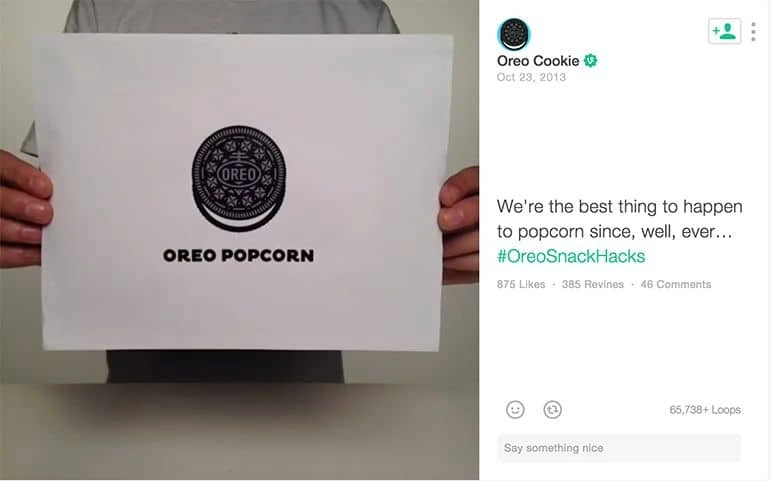
All this has earned Oreo 55.9k followers on Vine and over 3 million video loops. While recipe videos might not fit your brand, how about a product announcement featuring your team wearing lederhosen while yodeling? Or, you know… something like that.
Update: Vine has closed its doors, but the lesson of trying new platforms still stands. For example, has your brand considered Snapchat?
3. Monitor Twitter complaints: #HappyToHelp
Social media can help brands personalize and streamline their customer support, like when a customer tweets about a problem or complaint, and the brand promptly responds with a generous, thoughtful solution.
KLM, an airline operating out of the Netherlands, took this idea to the next level with their #HappyToHelp campaign. During the week of the social media campaign, they set up a control room in front of Amsterdam Schiphol Airport where they monitored thousands of tweets coming in from unhappy airline travelers. They paid special attention to customers having trouble with other airlines. Then they came to the rescue, retrieving forgotten visas, delivering a bed for a stranded traveler, and even singing a lullaby for someone who couldn’t sleep.
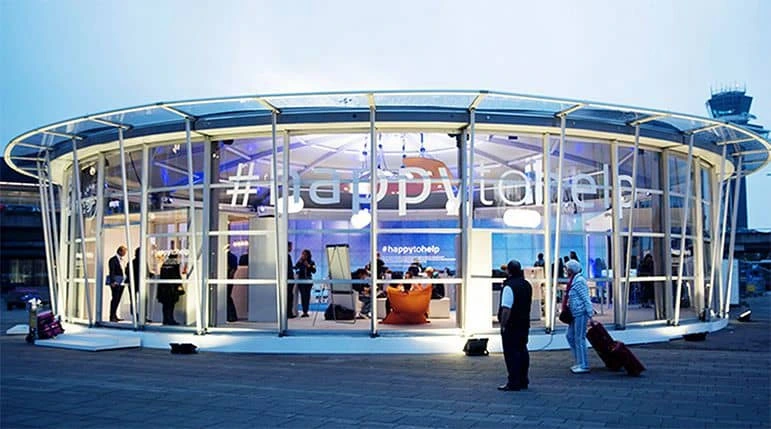
This smart campaign racked up 36 million impressions, and doubtless made a big impression of another kind on the many people who received personalized care from KLM. The genius of #HappyToHelp is that it reached competitors’ customers precisely when they were most dissatisfied with the customer service they were receiving. Monitoring Twitter for problems your customers are having is important, but you might consider checking for problems potential customers are having as well—and then solving them.
4. Make your own news: Pepsi
Pepsi has been around for a while, but that doesn’t stop them from innovating. The Pepsi team launched a social media campaign that caught the attention of London commuters by making it look like crazy things were happening on the street outside the bus stop. Here, just watch the video:
This campaign is interesting because it combines social media with a guerrilla street campaign. Pepsi created news by doing something interesting, and then marketed that news on their social channels. But it was done in a way that felt organic and natural, drawing people to the brand. The bus stop video has accumulated over 7 million views on Youtube in addition to all the people who saw it firsthand on the street.
5. Be helpful to your customers: Hellmann’s
What’s up with WhatsApp? It was the new kid on the social media block, but Facebook bought it for $19 billion, obviously seeing serious potential. Hellman’s (the mayonnaise company) saw that potential too and created a fun, helpful social media campaign centered around WhatsApp.
The campaign centers around a service called WhatsCook that empowers WhatsApp users to make something delicious using the ingredients they have on-hand. Here’s the situation: Angela (not a real person) is hungry. She has a few random ingredients in her refrigerator, but doesn’t know how to put them together. Using WhatsCook through WhatsApp, Angela can send a picture of the ingredients to a real chef who will suggest a recipe idea and then walk her through the cooking process. Pretty cool, right?
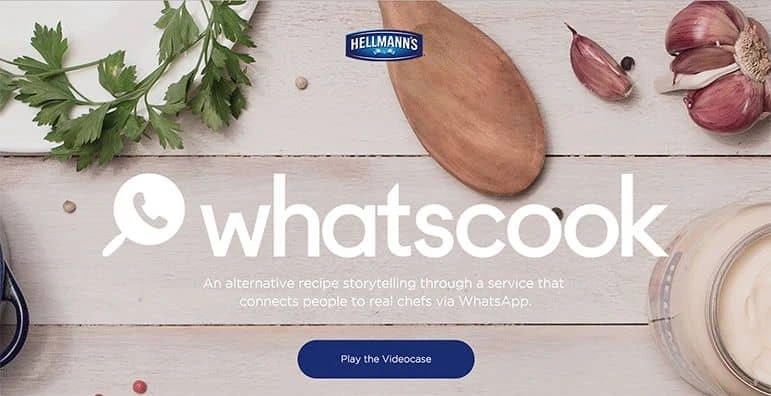
On average, users of the WhatsCook service spent 65 minutes interacting with the chef while they cooked. That’s a lot of time spent with a brand! Hellmann’s made at least two great calls with this campaign. First of all, they found a way that they could be truly helpful to customers and potential customers. There’s no rule that you can’t help your brand and help people at the same time. Secondly, Hellmann’s was willing to try something unique on a new platform. Sometimes you have to go out on a limb to find a gold mine.
6. Tap into the trends: Giformances
Leaders at The Katona József Theatre in Hungary were concerned that young people weren’t interested in theater because they saw it as out of touch with technology. So, the theater enlisted its top actors to create GIFs that expressed all kinds of different emotions, then put all the GIFs in an online catalogue called Giformances.
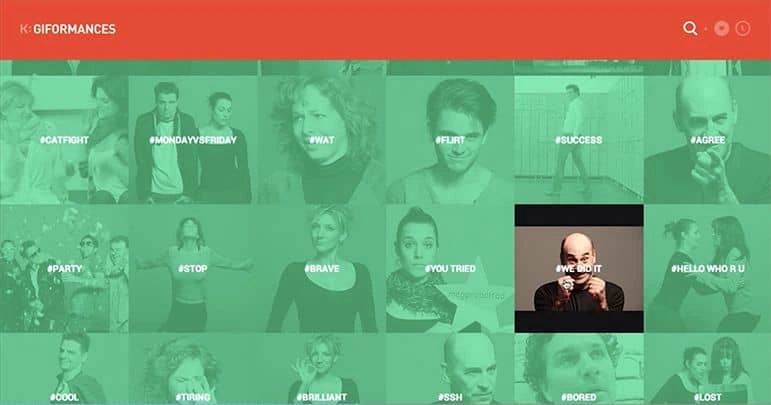
The response was impressive. Giformances got front-page news coverage on every major media outlet and was featured on primetime TV news. Plus, they’ve attracted over 200k unique users to date. Pretty good for a organization that felt it was unnoticed.
In this campaign, the Katona József Theatre demonstrated an awareness of cultural trends that would resonate with an audience they wanted to gain some traction with. In addition to considering a new social media platform for your campaign, you can also make waves by thinking of a unique way to present your content.
7. Showcase your use case: Living with Lag
People don’t like slow internet. So, it stands to reason that people will like a company who gives them fast internet. Ume.net, a fiber broadband provider, set out to prove their speediness in a unique way. They made a YouTube video of people trying to do everyday tasks with an Oculus Rift headset programmed with a three-second delay. The idea was to illustrate the woes of lagging internet in an offline setting. It was a light-hearted and creative campaign, and the YouTube video currently has almost 6 million views. Check it out:
Ume.net recognized that Oculus Rift headsets are en vogue right now, similar to the way the Katona József Theatre recognized the hipness of GIFs. Plus, ume.net invested in a great-looking video that did justice to their creative idea. It’s good to consider which campaigns can be done with little or no funding and which ones might require a little monetary love to take flight.
8. Time your efforts: Marie Callender’s
Ads are another option to consider when working with social media. Ads can leave a bad taste in our mouth, so when we see something that defies that expectation, it stands out. Marie Callender’s hit this nail on the head with tempting ads that spoke to the sudden craving for warm comfort food that might strike in cold weather. Here’s what they looked like:

The ads were wisely placed on Weather.com, targeting people who were checking the weather on a cold or rainy day. These aren’t social media ads, but the same principles of creativity and timing apply. Some great opportunities are holiday-themed posts or something that celebrates a milestone for your company (like this post). If you’re thoughtful with advertising and know the right moment to reach your customers, then you have a recipe for success.
9. Streamline the customer experience: Domino’s
When Domino’s was developing their social media strategy, they didn’t just fall back on the appeal of a delightful, melty slice of pizza. They took what is already inherently appealing about their brand and combined it with something that is quickly becoming almost as iconic as pizza: the emoji.
On Twitter, Domino’s fans can order a pizza by simply tweeting a pizza emoji. This is a unique and creative use of Twitter, and it’s particularly interesting because it is simultaneously a campaign and a transaction. That’s impressive efficiency. You can see from the photo below how many Twitter followers Domino’s has earned:
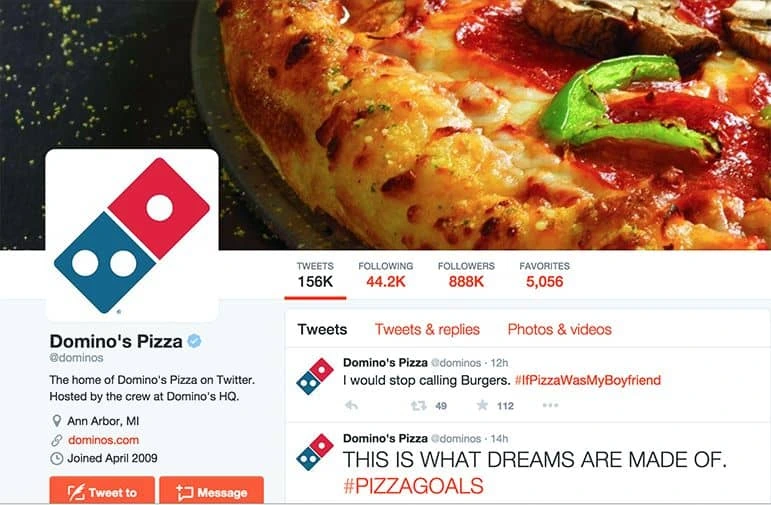
10. Match the campaign to the platform: #LastSelfie
Snapchat: the social media craze that has won the hearts of teens and millennials everywhere. Why not use it to inspire social activism? The World Wildlife Fund came up with a very clever way to utilize the Snapchat medium to rally support for endangered species. As is the case for all Snapchat photos, the ads that came up were only visible for a few seconds, then they were gone forever, hinting at the possibility of endangered animals disappearing for good if they go extinct.
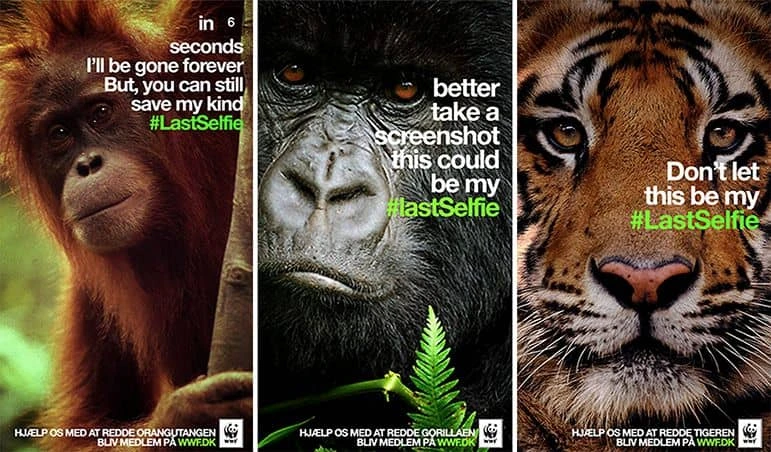
WWF reached their monthly donation goal in just 3 days thanks to this social media campaign. This is a great example of perfectly matching the campaign to the platform in order to really stand out. When you’re putting together your next campaign, consider taking time to note the core characteristics of a few different social media platforms. That way, you can tailor your ads to work in harmony with them.
The 10 best B2B social media campaigns you haven’t tried yet
By now, we’ve all heard how social media can support a brand and make it easier to connect with customers. But not all of us have the benefit of being a consumer-facing brand like Pepsi, Domino’s, or Oreo. If you’re representing a B2B brand, can you still take advantage of social media? Absolutely!
Here are 10 of our favorite examples of B2B brands using social media to build their brands and make an impact online
10. Build brand awareness: MailChimp on Instagram
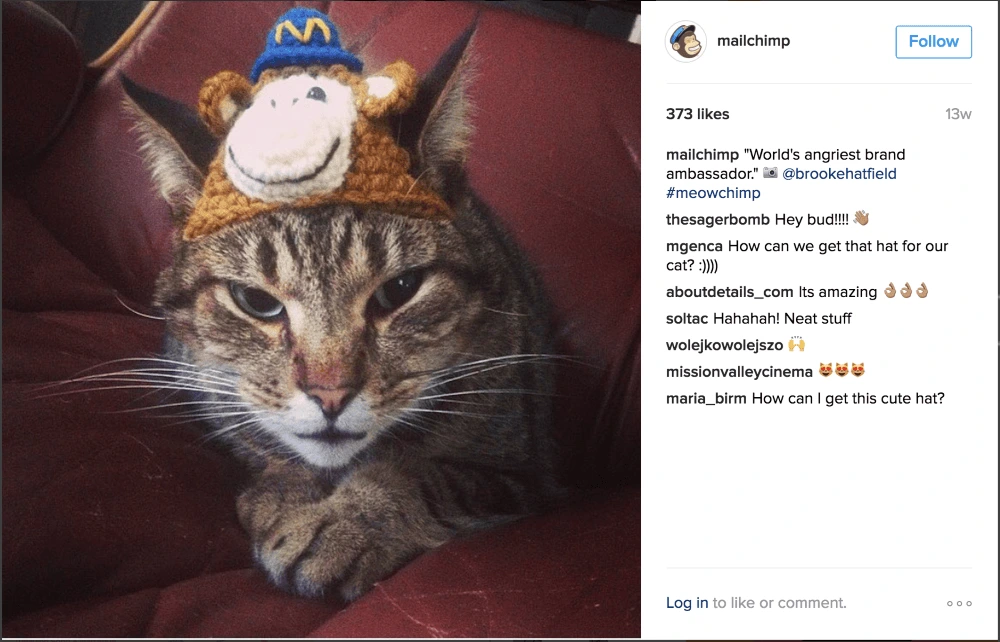
If you take a cursory glance at MailChimp’s Instagram account, one thing is immediately clear: That gosh-dang monkey is everywhere. (Forgive my crude Utah language.) But there’s a good reason for it. “Freddie” the monkey has been MailChimp’s loyal brand ambassador since the beginning, and while he’s gone through a few changes over the years, his fun personality still shines through.
As a visual platform, Instagram is specially suited to sharing Freddie’s shenanigans and encouraging MailChimp fans to do the same. From figurines to knitted caps, he is a constant reminder of the brand without being too ‘on the nose’, and he keeps MailChimp top-of-mind for its followers. (Bonus tip? On the internet, you can never go wrong with cats.)
9. Show off your expertise: Huawei on Twitter

Huawei is the largest manufacturer of telecommunications equipment in the world. Yet, if you asked the average American, it’s unlikely they’d know much about this giant company headquartered in China. That hasn’t stopped the brand from embracing social media in various countries and building up an appreciative audience for its content.
Huawei spotlights innovative technology trends and predictions for the future, inviting experts to weigh in on the tough questions (“Can AI ever function like a human?”) that make for rich conversations. Its Twitter timeline is chock-full of thought-provoking quotes from industry leaders.
By taking the time to create smart, dense content, Huawei sets itself apart from other social media accounts who find it easier to keep things fluffy.
8. Join relevant groups: Lucidpress on LinkedIn
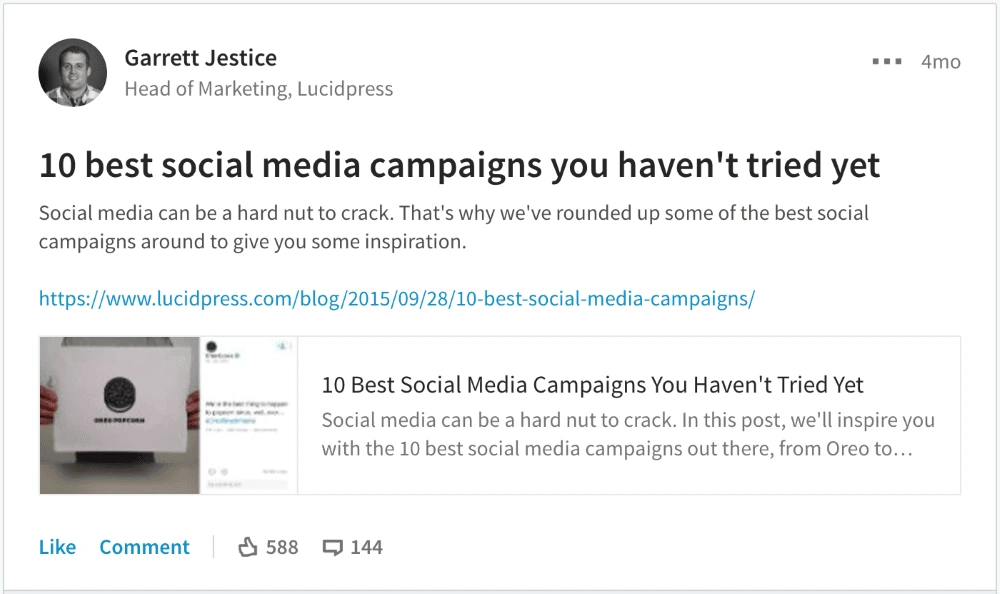
If we want to talk the talk, we’d better walk the walk.
Although Lucidpress isn’t strictly a B2B brand, we serve a large number of businesses who use Lucid’s software across various departments. To reach these businesses, we have found that it’s better to go where your audience is than to expect it to come to you. One way to do that is to join relevant LinkedIn groups and share your content with them. It’s this strategy that likely brought many of you here today, as a follow-up to one of our most successful LinkedIn conversations.
Due to the many comments and feedback in that conversation, we realized there was a content need we were not filling (that is, looking at social media from a B2B perspective), and it gave us the opportunity to serve our B2B users better.
7. Share your human side: Novartis on Facebook
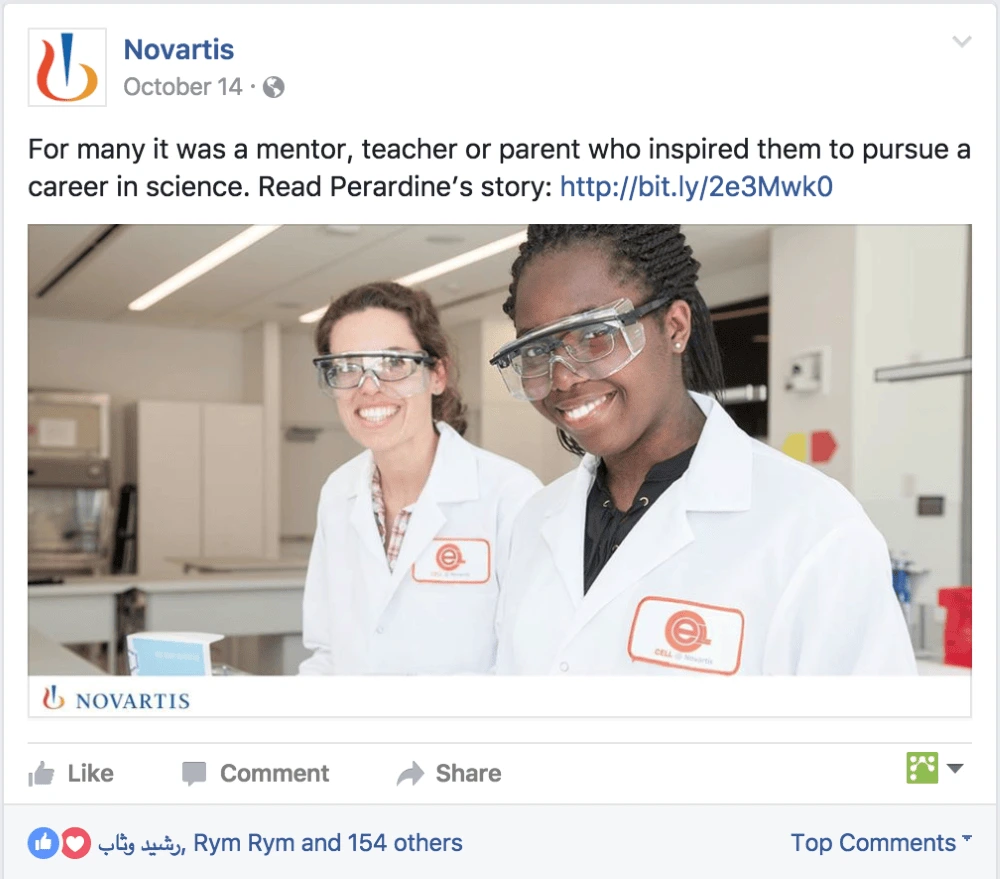
As a B2B brand, it can be difficult to express humanity online. What I mean by that is a corporation can start to feel like a faceless monolith (“We appreciate your business”) when compared to real, one-on-one connections with other people (“I’m so glad you called!”).
Novartis, the multinational pharmaceutical company, has found a wonderful way to remind us that organizations are made up of real people with unique stories and goals, by spotlighting individuals who work or intern there on its Facebook page.
The best part about this strategy is that any brand can use it, because every brand has fascinating people working behind the scenes. Take a look around your office and see who’s got a story to tell. We guarantee your users will relate and respond far better to that than to your next press release.
6. Create a community: American Express on Twitter
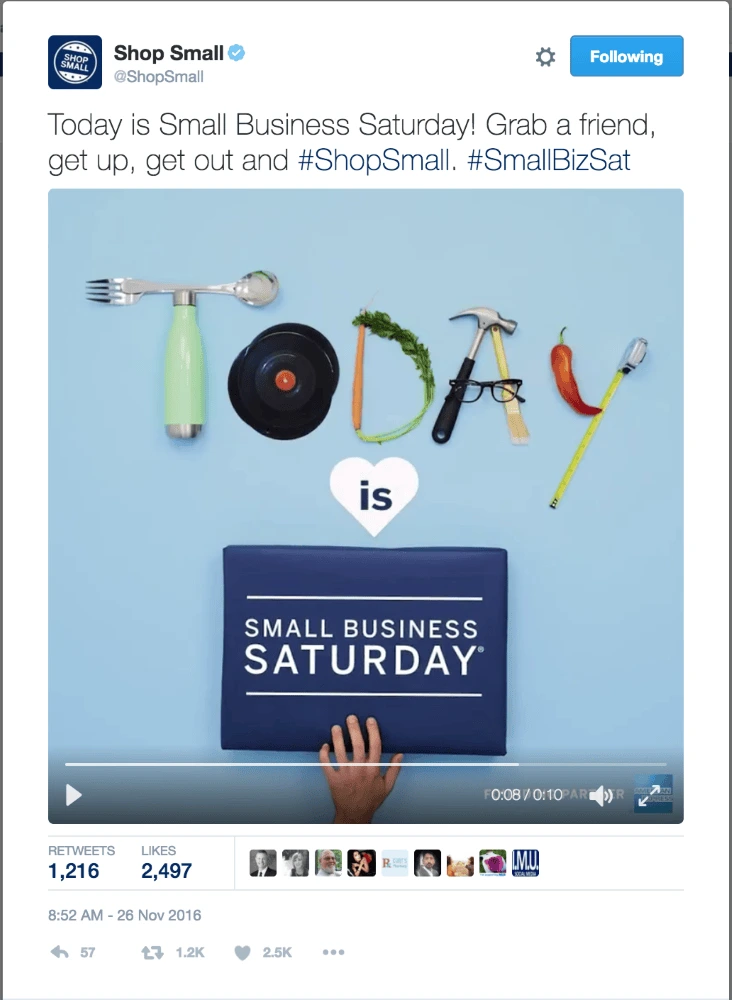
American Express has been recognized in the past for OPEN Forum, its small-business blog—and rightly so. But its dedication to serving SMBs crossed over into social media with the creation of the @ShopSmall Twitter account. @ShopSmall is active throughout the year, but things really ramp up in the fall in preparation for November’s #SmallBizSat.
If you haven’t heard, Small Business Saturday is a national holiday (first sponsored by American Express in 2010) that takes place between Black Friday and Cyber Monday. It encourages shoppers to support small and local businesses—just the kind of places American Express hopes to service.
@ShopSmall is a hyper-focused social media account that leverages the larger SMB community American Express has built over the years, and the community’s passion and enthusiasm are contagious.
5. Highlight user-created content: Maersk on Instagram

What do you get when you combine smartphone photography, shipping containers, and the open sea? For Maersk, the world’s largest container ship and supply vessel operator, you get one hell of an Instagram account. Thanks to pilots, sailors, and travel professionals around the world, Maersk has a deep well of user-generated photos to share with its 77.4k followers.
And the pictures are good. Like, really good. If you had told me that one of the best business Instagram accounts out there specialized in photos of shipping containers, I’m not sure you could’ve convinced me. But after scrolling past sun-lit ocean horizons, grand heavy ships that miraculously still float, and even the occasional double rainbow… I’m a believer.
(And, like Maersk, if you decide to use this tactic for your social media, don’t forget to credit the awesome folks who create branded content for you.)
4. Feature your customers: Square on Facebook
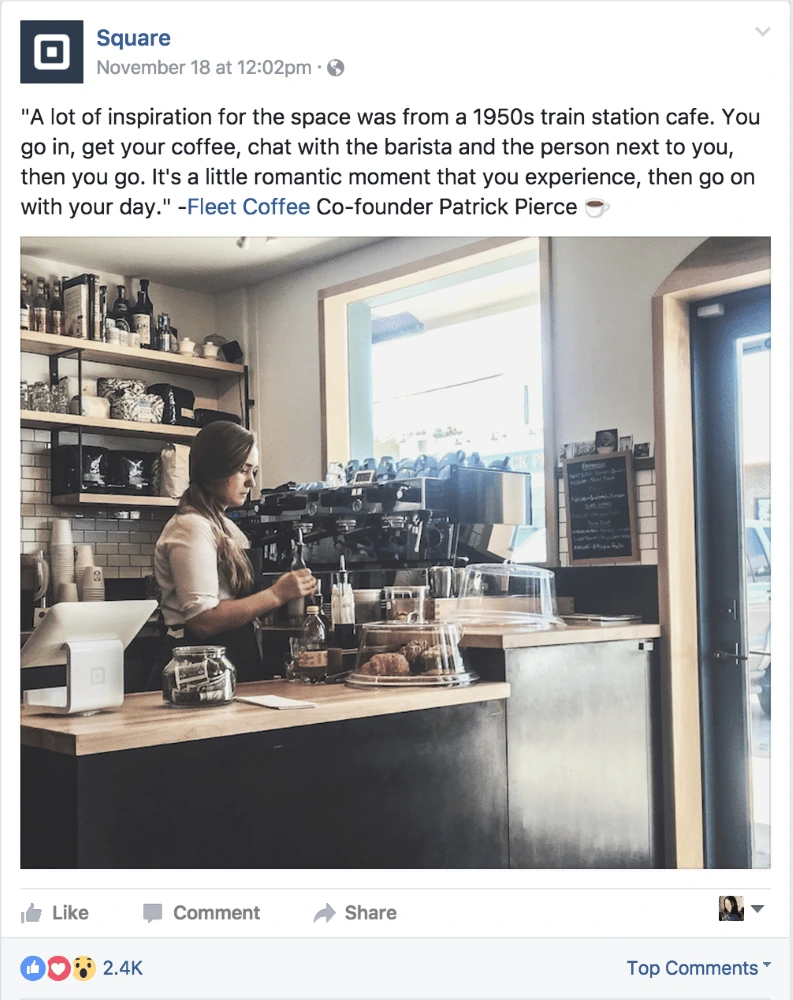
Like we learned from the Novartis example, stories about real people are compelling. But rather than turning its focus within, Square looks out towards its customers for social media inspiration.
Its Facebook page features slice-of-life photos of small businesses and the people who own them, people who depend on Square for payment processing. Next to the photo is a quote handpicked from a longer interview, where you get a glimpse into the daily lives of SMB owners around the country.
In this example, Fleet Coffee in Austin, Texas, is tagged so readers can easily visit their page. It’s not hard to imagine that this feature brought Fleet Coffee a few new followers—which is a nice way for Square to give a little bit back to the folks who keep them in business.
3. Display your culture: Intuit on LinkedIn
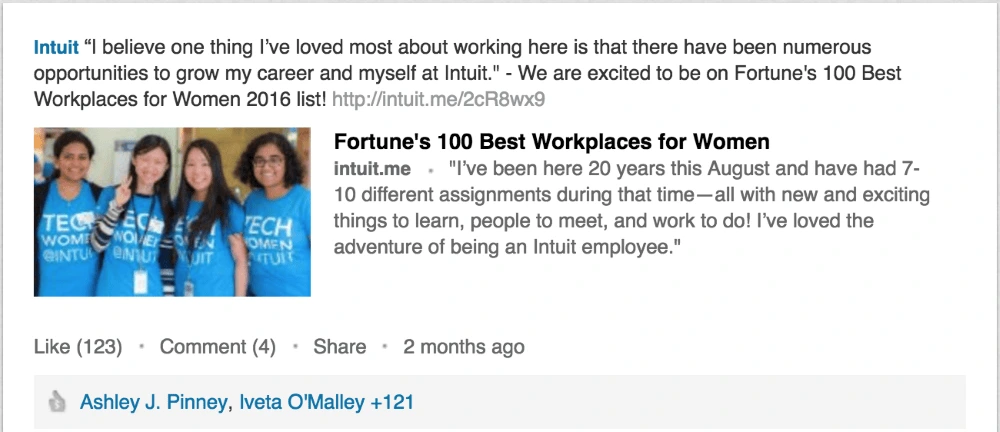
Got a company culture that you’re proud of? Share it! LinkedIn is the network of choice for business professionals, which means it’s the perfect place to share updates about awards, activities, and other exciting announcements pertaining to your company. As you can see in this update, the award shows that Intuit values a diverse culture that offers opportunities to women in tech.
Sharing what makes your company a great place to work offers dual benefits. First, it assures potential B2B clients and partners that you care about your people and will likely work hard to treat them fairly. Second, it attracts top talent who shares your values, which makes it easier to keep your culture strong. So don’t be shy—when it comes to culture, it’s okay to brag a little bit.
2. Give a peek behind the curtain: Sunnybrook Hospital on Twitter
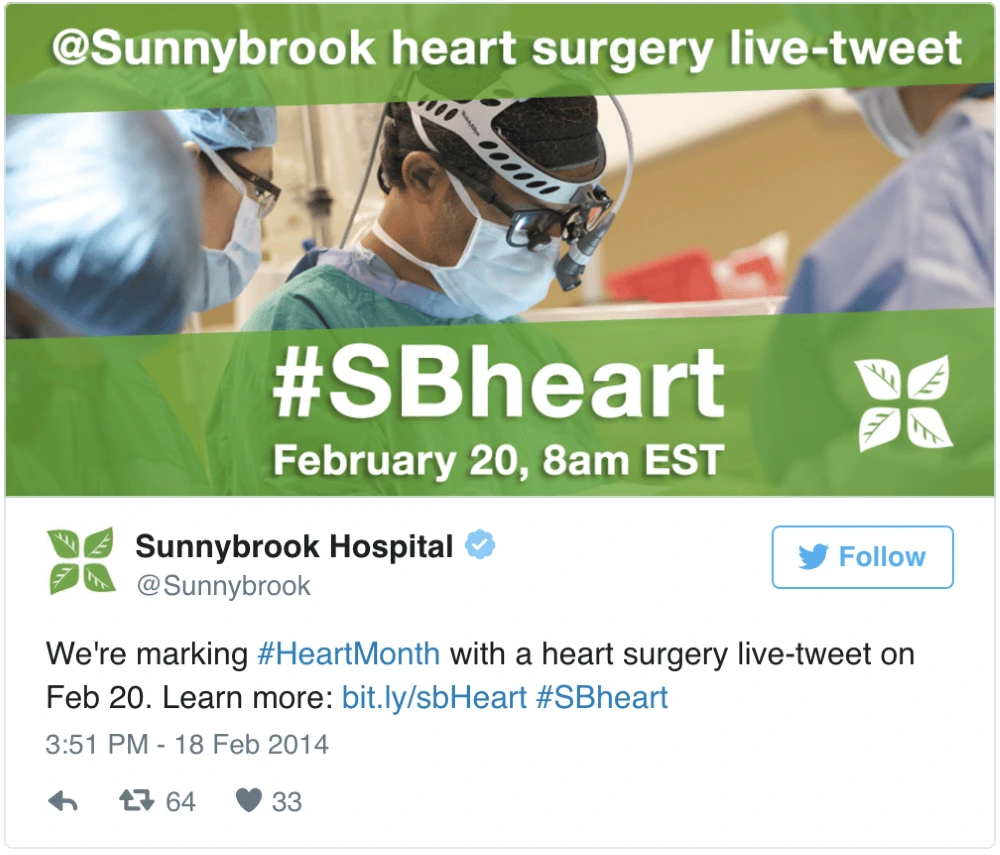
As you go about your daily work, consider that what might seem like regular routine to you could be fascinating and new for your audience. For example, take a look at the healthcare industry. Sunnybrook Hospital in Toronto, Ontario, came up with a fascinating way to give its followers a peak behind the curtain—by livetweeting a patient’s heart surgery.
As part of its efforts to raise awareness for Heart Month in February, the hospital livetweeted a coronary artery bypass graft over the course of nearly eight hours (with consent from the patient, of course). This unique use of social media attracted media coverage for their cause, which means the surgery and the strategy were both a great success.
To see the tweets, check out this Storify link (be advised: some tweets contain graphic medical content). Are there processes or procedures going on “behind the scenes” that you could share with your followers?
1. Don’t be afraid to try something new: General Electric on Instagram (Stories)
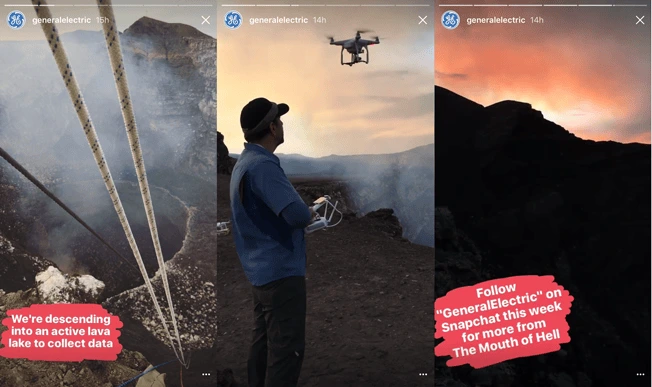
It’s almost impossible to talk about B2B social media without mentioning General Electric. The digital/industrial giant maintains a presence on all the major social networks and has earned praise for campaigns in the past like #ILookLikeAnEngineer, which highlighted women and minorities working in a white-male-dominated field. But what earns GE a spot on this list is not what they do on Facebook or Twitter.
It’s the willingness to experiment with new forms of social media, trying out innovative content and new platforms that might scare other brands away. GE was on Vine the day after it launched, it’s on Snapchat, and when Instagram launched Stories in August, GE was there with an exploration of the Masaya Volcano in Nicaragua.
While it might not keep or update every platform, GE strikes while the iron is hot and earns valuable views in the process.
It turns out that, with a little ingenuity, B2B brands can make just as big a splash on social media as any other brand. Next time you’re planning a social media campaign, try out some of these ideas.
How can you compete with the best social media campaigns? First of all, you need to know your customers well. To interact with them in a friendly way, you need to understand their desires and interests. Then it’s time to brainstorm and put your best social media campaign ideas into action. With hard work, you can run a clever, successful social media campaign that takes your brand to the next step, whether that’s getting it on the map or earning a million more customers.
Eager to adapt your brand to social media channels? Grab a copy of our free eBook: How to adapt your brand to social media
By now, we’ve all heard how social media can support a brand and make it easier to connect with customers. But not all of us have the benefit of being a consumer-facing brand like Pepsi, Domino’s, or Oreo. If you’re representing a B2B brand, can you still take advantage of social media? Absolutely!
Is your brand new to social media? Grab a copy of our free eBook: How to adapt your brand to social media
As a follow-up to one of our most popular posts, here are 10 of our favorite examples of B2B brands using social media to build their brands and make an impact online.
10. Build brand awareness: MailChimp on Instagram
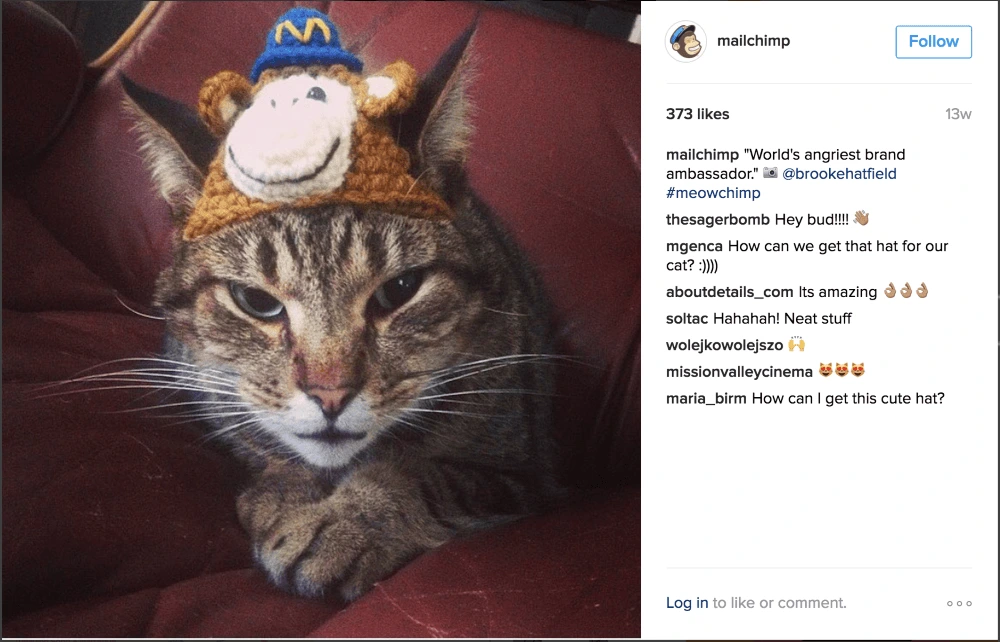
If you take a cursory glance at MailChimp’s Instagram account, one thing is immediately clear: That gosh-dang monkey is everywhere. (Forgive my crude Utah language.) But there’s a good reason for it. “Freddie” the monkey has been MailChimp’s loyal brand ambassador since the beginning, and while he’s gone through a few changes over the years, his fun personality still shines through.
As a visual platform, Instagram is specially suited to sharing Freddie’s shenanigans and encouraging MailChimp fans to do the same. From figurines to knitted caps, he is a constant reminder of the brand without being too ‘on the nose’, and he keeps MailChimp top-of-mind for its followers. (Bonus tip? On the internet, you can never go wrong with cats.)
9. Show off your expertise: Huawei on Twitter

Huawei is the largest manufacturer of telecommunications equipment in the world. Yet, if you asked the average American, it’s unlikely they’d know much about this giant company headquartered in China. That hasn’t stopped the brand from embracing social media in various countries and building up an appreciative audience for its content.
Huawei spotlights innovative technology trends and predictions for the future, inviting experts to weigh in on the tough questions (“Can AI ever function like a human?”) that make for rich conversations. Its Twitter timeline is chock-full of thought-provoking quotes from industry leaders.
By taking the time to create smart, dense content, Huawei sets itself apart from other social media accounts who find it easier to keep things fluffy.
8. Join relevant groups: Lucidpress on LinkedIn
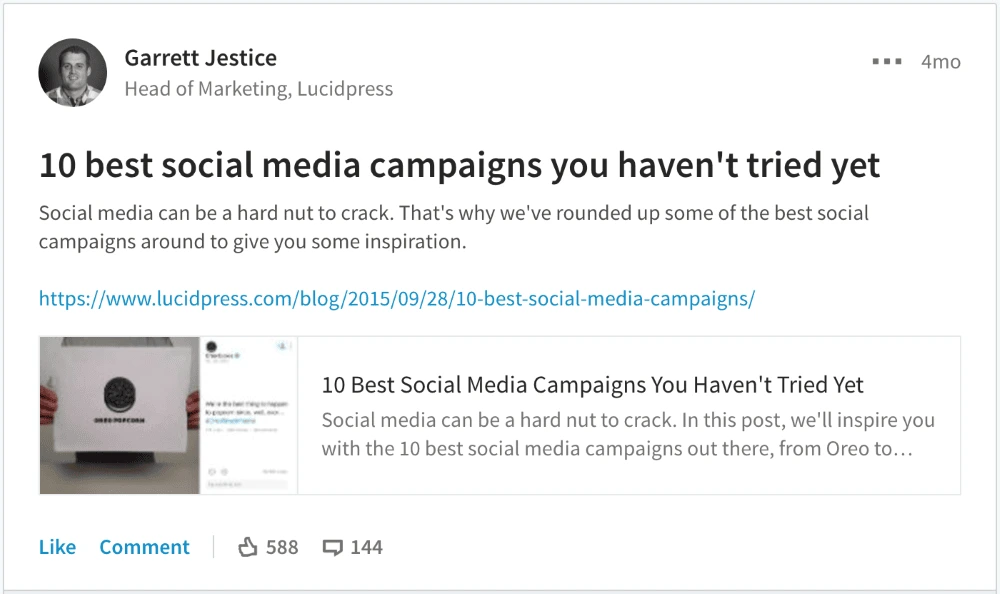
If we want to talk the talk, we’d better walk the walk.
Although Lucidpress isn’t strictly a B2B brand, we serve a large number of businesses who use Lucid’s software across various departments. To reach these businesses, we have found that it’s better to go where your audience is than to expect it to come to you. One way to do that is to join relevant LinkedIn groups and share your content with them. It’s this strategy that likely brought many of you here today, as a follow-up to one of our most successful LinkedIn conversations.
Due to the many comments and feedback in that conversation, we realized there was a content need we were not filling (that is, looking at social media from a B2B perspective), and it gave us the opportunity to serve our B2B users better.
7. Share your human side: Novartis on Facebook
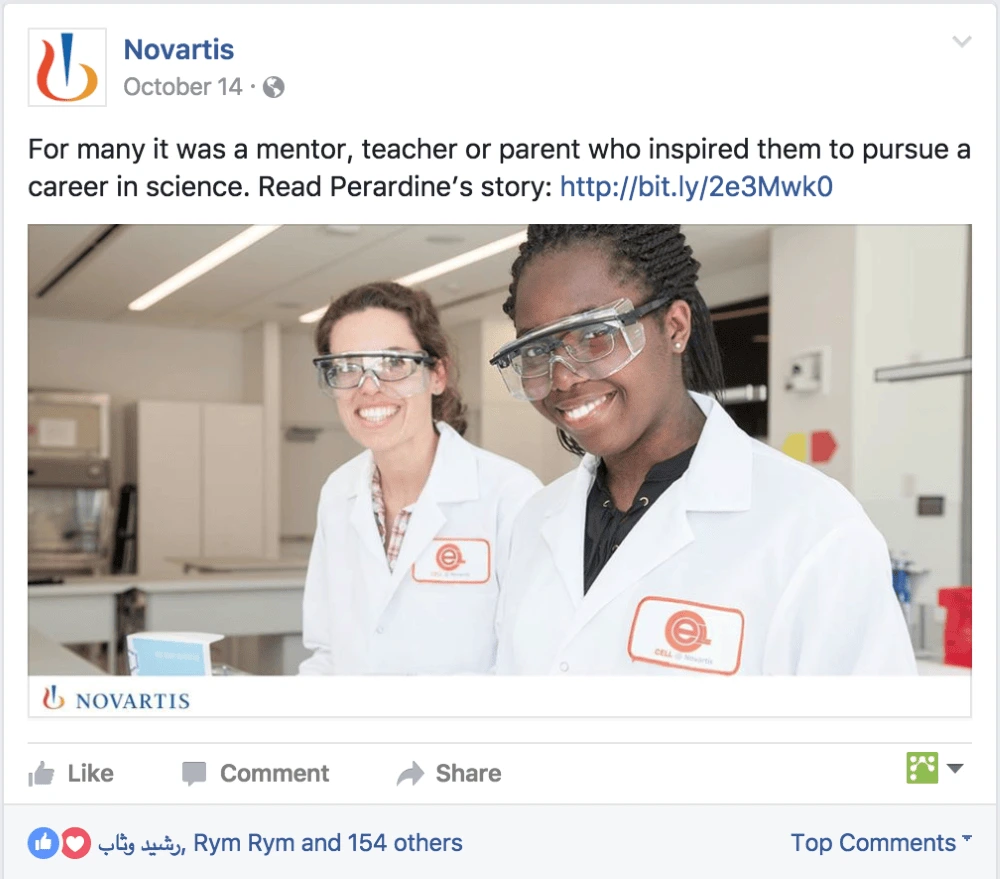
As a B2B brand, it can be difficult to express humanity online. What I mean by that is a corporation can start to feel like a faceless monolith (“We appreciate your business”) when compared to real, one-on-one connections with other people (“I’m so glad you called!”).
Novartis, the multinational pharmaceutical company, has found a wonderful way to remind us that organizations are made up of real people with unique stories and goals, by spotlighting individuals who work or intern there on its Facebook page.
The best part about this strategy is that any brand can use it, because every brand has fascinating people working behind the scenes. Take a look around your office and see who’s got a story to tell. We guarantee your users will relate and respond far better to that than to your next press release.
6. Create a community: American Express on Twitter
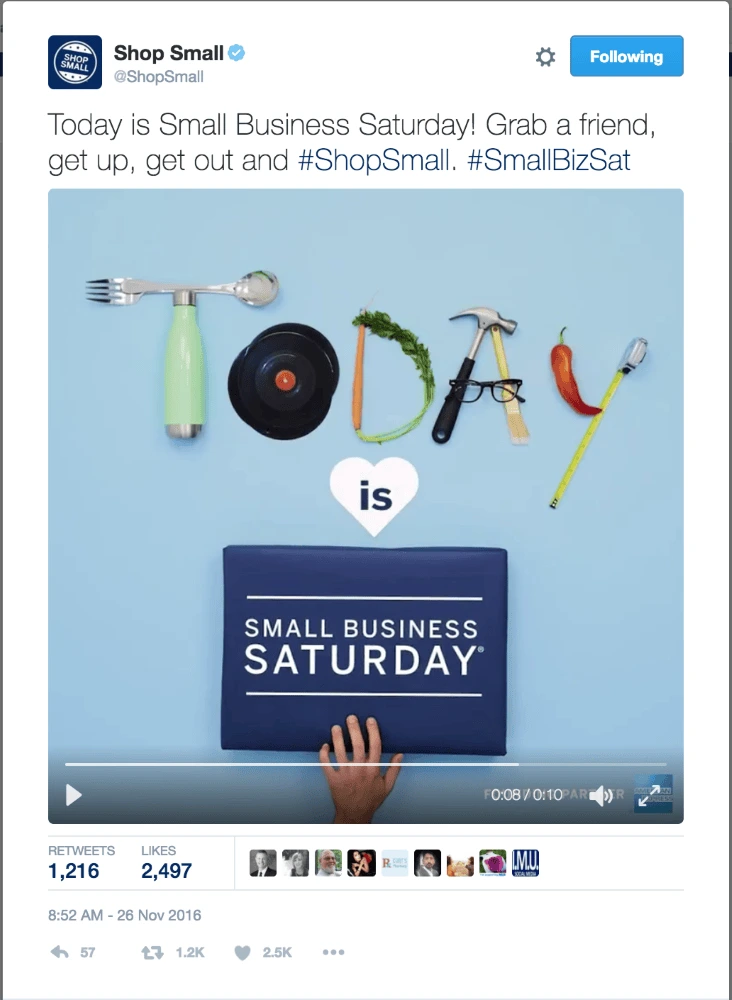
American Express has been recognized in the past for OPEN Forum, its small-business blog—and rightly so. But its dedication to serving SMBs crossed over into social media with the creation of the @ShopSmall Twitter account. @ShopSmall is active throughout the year, but things really ramp up in the fall in preparation for November’s #SmallBizSat.
If you haven’t heard, Small Business Saturday is a national holiday (first sponsored by American Express in 2010) that takes place between Black Friday and Cyber Monday. It encourages shoppers to support small and local businesses—just the kind of places American Express hopes to service.
@ShopSmall is a hyper-focused social media account that leverages the larger SMB community American Express has built over the years, and the community’s passion and enthusiasm are contagious.
5. Highlight user-created content: Maersk on Instagram

What do you get when you combine smartphone photography, shipping containers, and the open sea? For Maersk, the world’s largest container ship and supply vessel operator, you get one hell of an Instagram account. Thanks to pilots, sailors, and travel professionals around the world, Maersk has a deep well of user-generated photos to share with its 77.4k followers.
And the pictures are good. Like, really good. If you had told me that one of the best business Instagram accounts out there specialized in photos of shipping containers, I’m not sure you could’ve convinced me. But after scrolling past sun-lit ocean horizons, grand heavy ships that miraculously still float, and even the occasional double rainbow… I’m a believer.
(And, like Maersk, if you decide to use this tactic for your social media, don’t forget to credit the awesome folks who create branded content for you.)
4. Feature your customers: Square on Facebook
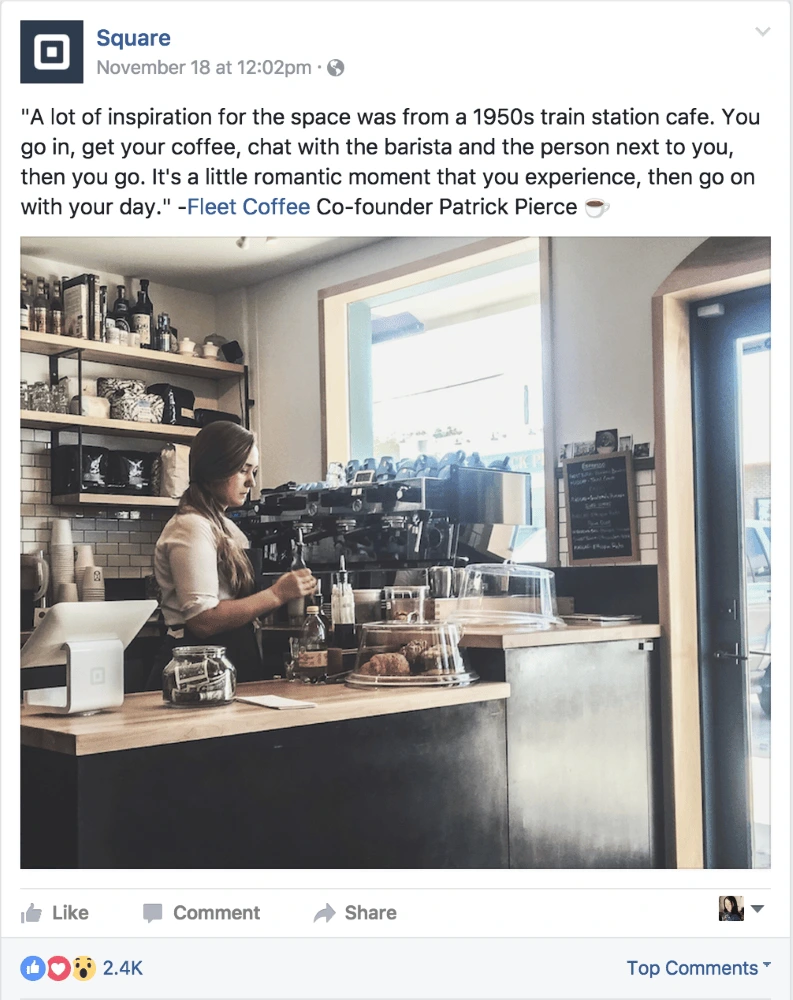
Like we learned from the Novartis example, stories about real people are compelling. But rather than turning its focus within, Square looks out towards its customers for social media inspiration.
Its Facebook page features slice-of-life photos of small businesses and the people who own them, people who depend on Square for payment processing. Next to the photo is a quote handpicked from a longer interview, where you get a glimpse into the daily lives of SMB owners around the country.
In this example, Fleet Coffee in Austin, Texas, is tagged so readers can easily visit their page. It’s not hard to imagine that this feature brought Fleet Coffee a few new followers—which is a nice way for Square to give a little bit back to the folks who keep them in business.
3. Display your culture: Intuit on LinkedIn
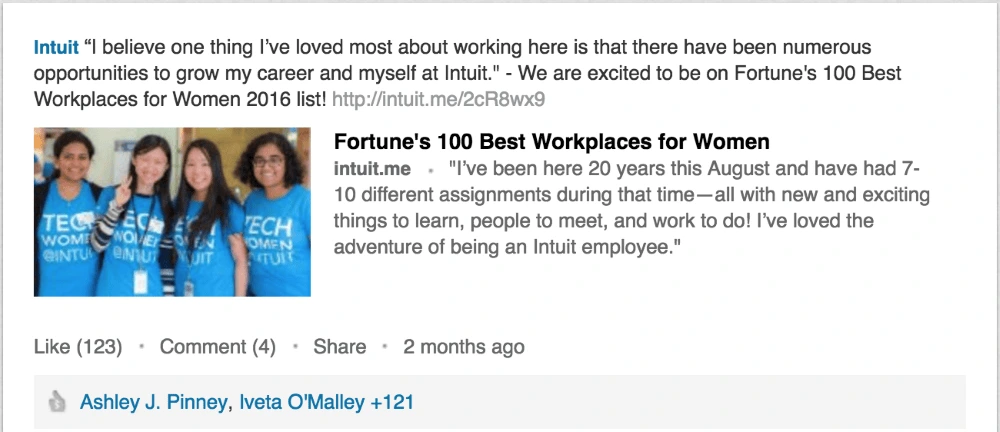
Got a company culture that you’re proud of? Share it! LinkedIn is the network of choice for business professionals, which means it’s the perfect place to share updates about awards, activities, and other exciting announcements pertaining to your company. As you can see in this update, the award shows that Intuit values a diverse culture that offers opportunities to women in tech.
Sharing what makes your company a great place to work offers dual benefits. First, it assures potential B2B clients and partners that you care about your people and will likely work hard to treat them fairly. Second, it attracts top talent who shares your values, which makes it easier to keep your culture strong. So don’t be shy—when it comes to culture, it’s okay to brag a little bit.
2. Give a peak behind the curtain: Sunnybrook Hospital on Twitter
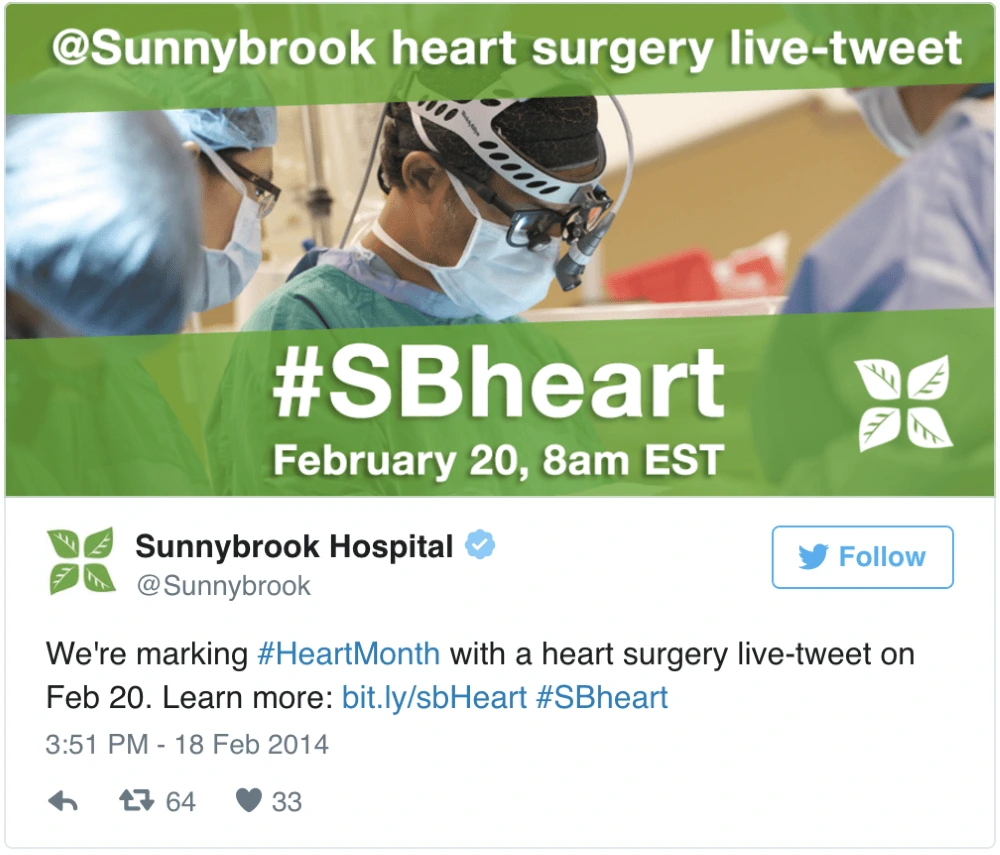
As you go about your daily work, consider that what might seem like regular routine to you could be fascinating and new for your audience. For example, take a look at the healthcare industry. Sunnybrook Hospital in Toronto, Ontario, came up with a fascinating way to give its followers a peak behind the curtain—by livetweeting a patient’s heart surgery.
As part of its efforts to raise awareness for Heart Month in February, the hospital livetweeted a coronary artery bypass graft over the course of nearly eight hours (with consent from the patient, of course). This unique use of social media attracted media coverage for their cause, which means the surgery and the strategy were both a great success.
To see the tweets, check out this Storify link (be advised: some tweets contain graphic medical content). Are there processes or procedures going on “behind the scenes” that you could share with your followers?
1. Don’t be afraid to try something new: General Electric on Instagram (Stories)
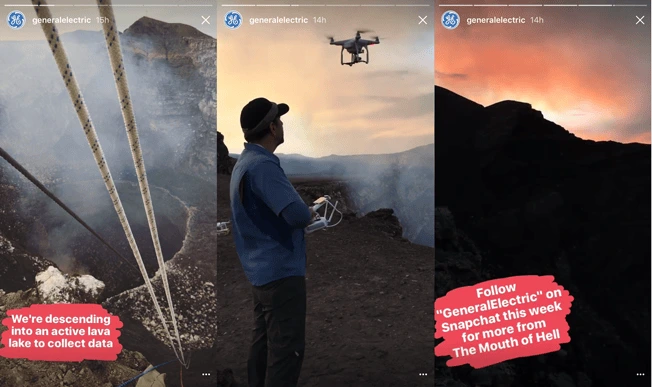
It’s almost impossible to talk about B2B social media without mentioning General Electric. The digital/industrial giant maintains a presence on all the major social networks and has earned praise for campaigns in the past like #ILookLikeAnEngineer, which highlighted women and minorities working in a white-male-dominated field. But what earns GE a spot on this list is not what they do on Facebook or Twitter.
It’s the willingness to experiment with new forms of social media, trying out innovative content and new platforms that might scare other brands away. GE was on Vine the day after it launched, it’s on Snapchat, and when Instagram launched Stories in August, GE was there with an exploration of the Masaya Volcano in Nicaragua.
While it might not keep or update every platform, GE strikes while the iron is hot and earns valuable views in the process.
It turns out that, with a little ingenuity, B2B brands can make just as big a splash on social media as any other brand. Next time you’re planning a social media campaign, try out some of these ideas. Did we miss any of your favorites? Share them in the comments below!
Is your brand new to social media? Grab a copy of our free eBook: How to adapt your brand to social media
When used correctly, Facebook advertising can be an incredibly effective tool to boost sales. But before you can expect people to whip out their credit cards and buy out your inventory, you need to establish brand affinity. In this post, we’ll go over just a few of the best ways you can maintain your current following and attract new customers.
Related: 5 ways to grow your email marketing list with Facebook
1. Create captivating, on-brand creative
One of the most important tasks of a successful Facebook advertising campaign is to create ads that will catch the eye of target consumers—which can be difficult to achieve since there’s so much competition on the platform. Using alluring images and bright colors in your ads is a good start, but be careful. If you have 20 advertisements that all use different styles and colors, it’s unlikely that new customers will gain any familiarity with your brand. Instead, stick with brand colors whenever possible and always include your logo in the ad. You should also use the same principal font that’s on your site, and never use more than two fonts in one ad.
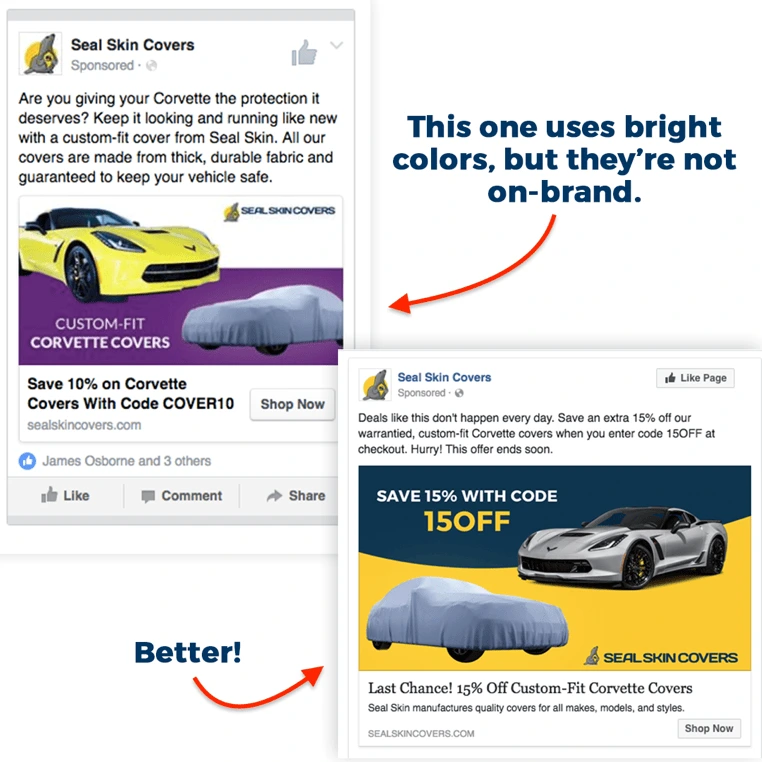
2. Use targeting filters and “Lookalike audiences” to find new fans
While remarketing campaigns are like shooting a fish in a barrel, finding new consumers who will have a genuine interest in your brand is a far more challenging task. Luckily, Facebook has a variety of unique targeting features that can help you refine your audience. Consider the demographics, behaviors and interests of your ideal customer and use that information to narrow your selection. For example, if you own a bridal shop and want to increase your wedding dress sales, you could target people who recently became engaged.
Facebook also has a unique feature called Lookalike audiences. With this tool, you can import a list of existing customers, and the platform’s algorithm will automatically identify new consumers who are likely to have an interest in your products or services. This can be an incredibly valuable tool for new brands looking to grow their fan base.
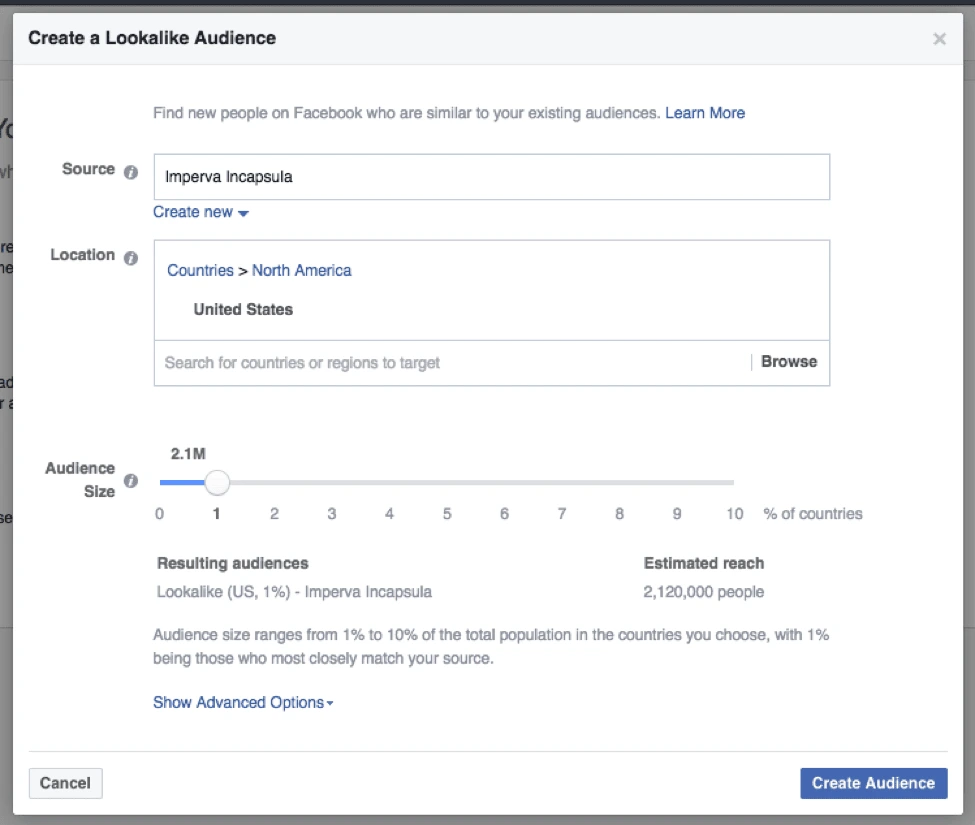
3. Establish a brand voice—and stick with it
To build strong brand affinity on Facebook, use ad copy that aligns with your unique brand voice. For example, if you own a mortgage firm and your brand voice is authoritative and professorial, then you don’t want to run ads that are filled with over-the-top puns and jokes. It’s also important to be consistent with your terminology. If your e-commerce company refers to buy-one-get-one-free sales as “BOGO,” this should be a consistent term in all your ads. If you have more than one person writing copy for your Facebook ads, create a style guide with tips and rules to follow.
When crafting your brand-consistent copy, be sure to write in a way that appeals to your target audience. Alongside the ad’s image or video, copy and headlines are important deciding factors in whether the consumer clicks your ad.
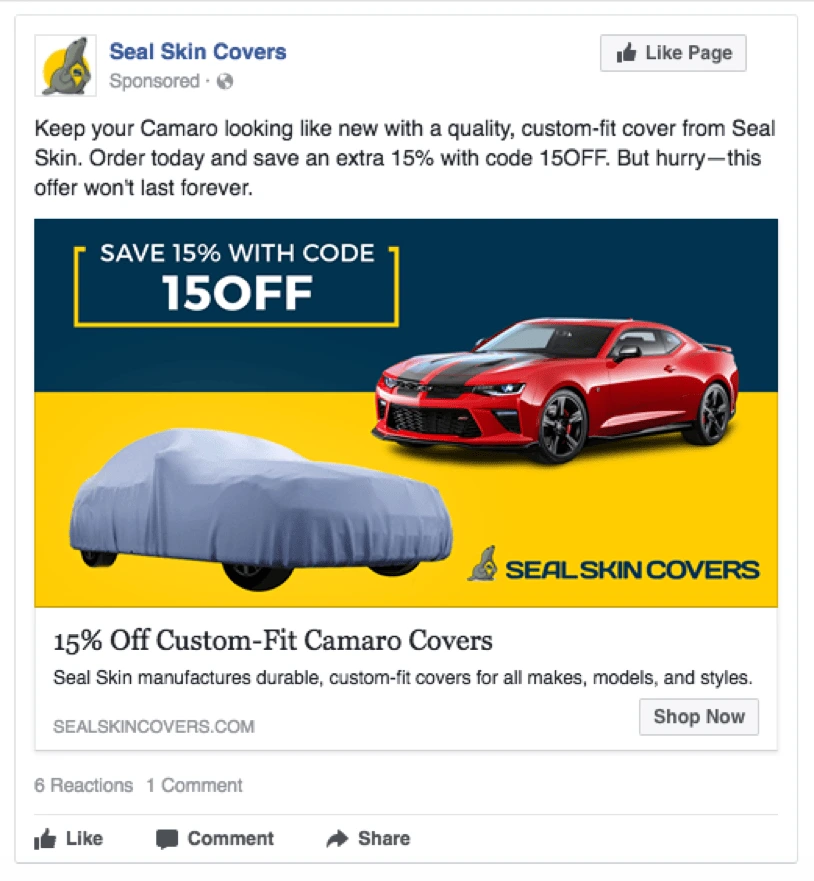
4. Advertise free content, too
Instead of focusing exclusively on advertisements that sell your products and services, promote free content that will spark an interest in your brand and help consumers see you as an industry authority. This is particularly wise when you’re marketing to new leads who’ve never heard of your company before. You want to offer some informative content that will warm up your leads—such as a free guide, video, blog post or infographic. Once the consumer has clicked through to your site, you can move them further down your marketing funnel by entering them into retargeting ads for other content offers or products.
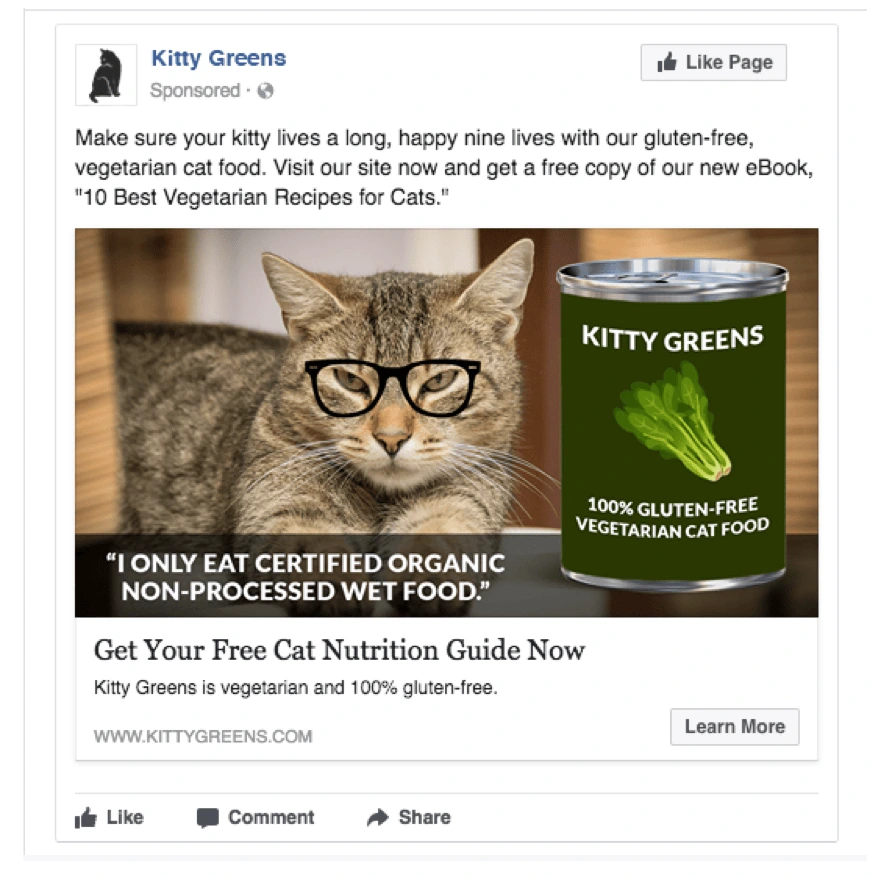
Ready to make a social splash? Create an updated Facebook cover.
Engaging followers on social media to boost your brand’s popularity is a fine art. Undoubtedly, your audience is spending a sizable chunk of their time on social, but there are way too many things competing for their attention there.
Related: 10 best social media campaigns you haven’t tried yet
If you don’t want to simply get scrolled past in the news feed, you need a better social media strategy. And to build one, you need to experiment with different techniques. Today, we’re going to take notes from the pros. Here are 5 social media hacks to get the right people to notice your brand, engage with your content, and share your posts.
1. Starbucks—Involve your audience in your campaign
A picture is worth a thousand words, right? Well, what if you could share your product’s best pictures on Instagram… by getting your followers to do it for you? That’s exactly what Starbucks has done with a host of seasonal hashtags.
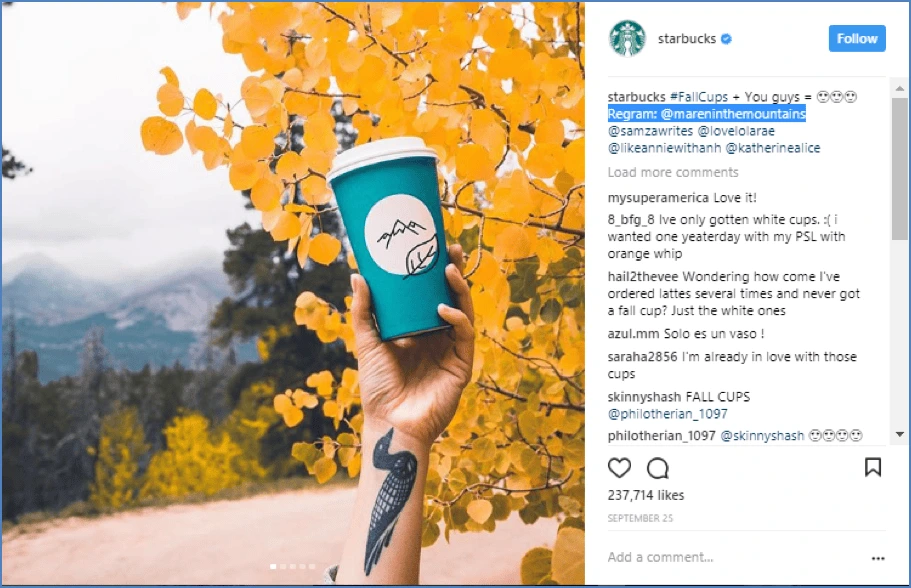
Source: Instagram
Starbucks constantly encourages followers to share their photos and, over time, has built a very active community of coffee lovers. They post their photos, and Starbucks shares the ones they like best.
As a result, the photo-taker gets attention and accolades, reinforcing the positive affinity they have for the brand. And Starbucks gets to spread beautiful pictures of their product that drive more engagement with their content.
You too can explore this option, starting by building a small community of users who love your product. Invite them to share pictures of themselves using your product, and watch how a win-win game can score points both for you and for your audience.
2. Just Eat—Hashtag your giveaways
Giving away freebies isn’t exactly a groundbreaker in business strategy, but there’s a better way to gain maximum impact. The food delivery app Just Eat nails this practice. It’s constantly running themed contests and food giveaways that ask users to tag their friends, send in entries, and generally join in the fun. As a result, for every item given away, Just Eat earns a great deal of traction and puts people in just the right mood for ordering food. #FindYourFlavor, #JustEatUK and #StrangerThings2 are just a few examples.
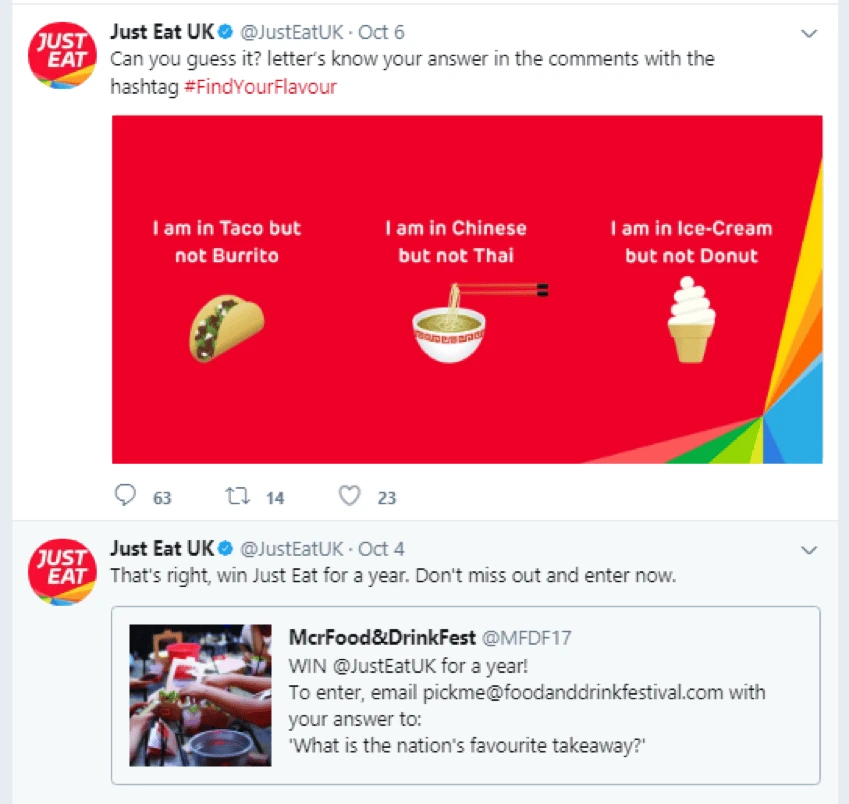
Source: Twitter
3. Lyft—Start a conversation
“While rival Uber is an efficient delivery service, Lyft is seeking to differentiate itself by offering a combination of ‘humanity and technology.”
Kira Wampler, Lyft CMO
Lyft crafts its social media strategy in that same vein by posting customer reviews, messages and conversations on their Twitter page. It aims to establish an identity as a warm, friendly taxi experience that nurtures relationships and cares about every single passenger. In fact, fantastic customer service has been Lyft’s calling card from the start, so playing it up on social media is a smart, brand-consistent move.
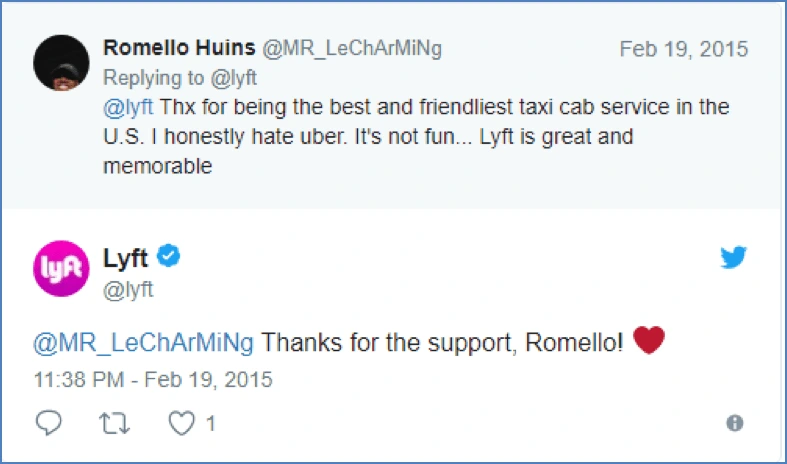
Source: Twitter
We all want to do business with brands that make us feel special. [![]() ] Forming personal relationships through conversation is basic human nature. You too can try exhibiting your warm, personal side by sharing users’ comments and conversations on your profile.
] Forming personal relationships through conversation is basic human nature. You too can try exhibiting your warm, personal side by sharing users’ comments and conversations on your profile.
4. Pokémon Go—Roll out teasers before major updates
Pokémon Go brought augmented reality gaming to the masses and attracted a huge fanbase in very little time. However, with shrinking attention spans, the initial excitement could’ve fizzled out quickly if they didn’t find ways to keep the buzz going.
Fans of Pokémon Go are treated to small doses of upcoming excitement through a regular cadence of trailers and teasers. The anticipation for new levels, more items, and higher scores is enough to make fans look forward to playing every update, making it one of the highest grossing games ever.
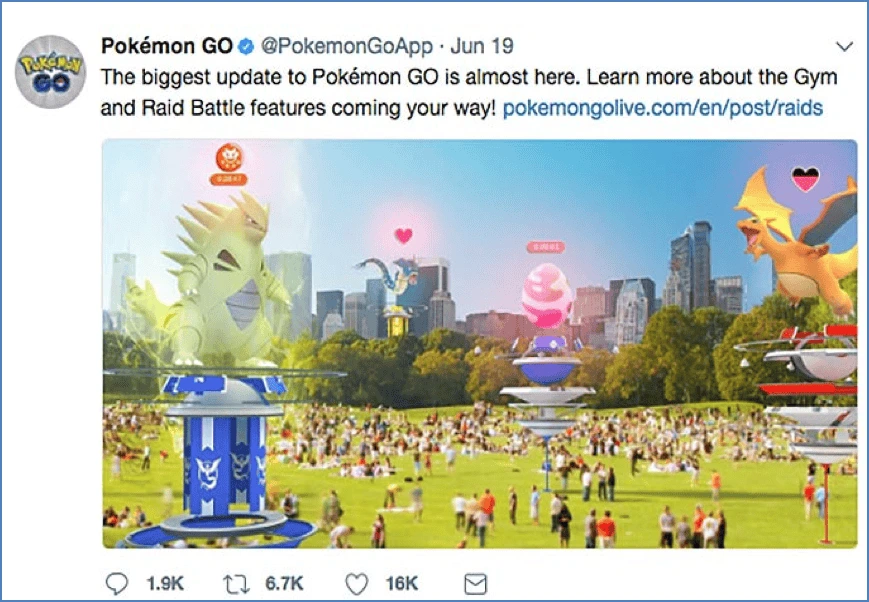
Source: Facebook
If you have a major update coming out, tease your followers with alluring clues, images and videos. This will keep the excitement alive until the update is finally out.
5. Angry Birds—Have a little fun with games
Angry Birds has been on social media since 2009, and from the start, their team has infused their brand’s personality with the fun of gaming. They are constantly running fun contests, posting fan artwork, giving away extra lives, and adding a light touch of humor to everything they post.
Plus, it’s not just your typical “share to win” giveaways. Contests come with clues and incentives to lure people into downloading the app. Riddles, puzzles, cryptic images and poems, it’s all there to keep users tuned in. Sometimes all it takes is a little fun and games to keep your audience engaged.
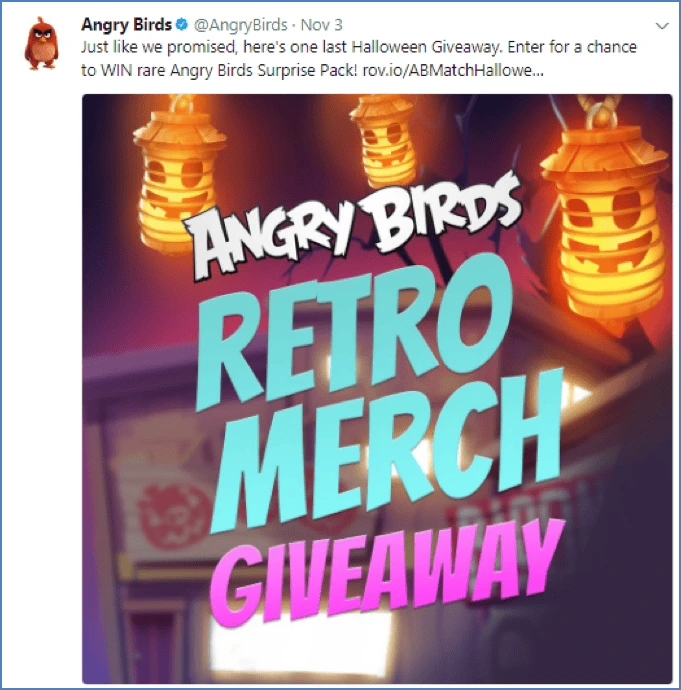
Source: Twitter
Wrapping up
Now you have 5 tried-and-tested strategies straight from the pros. These techniques can be adjusted and applied to nearly any brand willing to experiment with creative flair. The idea is to build connections and foster relationships with your users so you become part of their social lives. Try one (or more!) of the above tips and see how your audience responds—you might be surprised at your success.
Ready to drive more engagement and leads with social media? Grab a copy of our free eBook: How to adapt your brand to social media
Before the rise of social media platforms, marketers relied on evergreen content. Evergreen content is content that’s always interesting, valuable or relevant to readers.
In contrast, ephemeral content is content that’s designed to last for only 24 hours. Snapchat, Instagram Stories and Facebook Live are all examples of places to post ephemeral content.
Related: How to use memes for social media marketing
The psychological concept of FOMO (the fear of missing out) makes ephemeral content great at increasing customer engagement.
Here, we’ll discuss how you can take advantage of FOMO to build your brand with ephemeral content.
Why should brands create ephemeral content?
When Snapchat came to smartphones, many people didn’t get it. What was the point in making a video or a photo that would disappear?
At that time, content creators focused on creating evergreen content to capture the interest of readers and stand the test of time.
Although evergreen content lasts, ephemeral content offers a sense of exclusivity. If you miss it, you miss it for good.
By making content ephemeral, you can keep your audience on its toes. They don’t want to miss out, so they pay attention. And on the internet, attention is king.
Large brands are already taking advantage of FOMO with their content. In 2016, an estimated 21% of BuzzFeed’s total traffic came from Snapchat views. As of 2018, Instagram Stories has an estimated 400 million users.
If you don’t get in on this trend soon, you’ll be the one who ends up with a bad case of FOMO.
How to use ephemeral content effectively
Ephemeral content offers unique ways to engage an audience. There are several different strategies you can use, depending on your preferred platform. Here are a few of them.
Reach out to your users and make them feel special
First, you have to reach out to your users. There are two good ways to do this: remarketing and influencer marketing.
If you’ve already established contact with your users, you can try remarketing. Use remarketing to announce new products, sales or discounts on products or services they’ve bought before to keep your audience engaged.
If you haven’t reached your audience yet, you can tap influencers to attend expos or invite-only events. Provide opportunities for them to take great pictures and try out your product. These influencers can then share their experiences with your brand via their social media accounts.
Keep in mind that not all fans have the clout or money to go to these events. Instead, you can give your regular users a “sneak peek” that not only makes them feel special, but also makes your brand feel real and authentic.
Be authentic and humanize your brand
Speaking of authenticity, one of the things that makes ephemeral content attractive is that it feels more real. However, to do this, you first have to know who you are and what you want to do as a brand.
According to Shopify, putting to paper the intangible facets of your brand (e.g. principles, philosophies, etc.) “should provide an ample introduction of why you’re in business, why you’re different, what you have going for you, and why you’re a good bet if you’re asking for an investment.” These will give you a guide for how to appear more authentic in your social media posts.
But, it’s not enough to know who you are and why. You also have to run your brand in line with your identity. When you have an identity and stick to it, it’s reflected in your content. Users like seeing employees at work behind the scenes—or real people using products in their own way. Take advantage of this and show users the unpolished side of your brand.
Keep your audience on its toes with live video
Live video is one way to show your audience that you’re authentic. But aside from that, it hooks them immediately.
When you use live video, your users are the seeing it at the same time as everyone else. According to Facebook, users spend up to three times more of their time watching live videos than non-live videos.
Here are a few ways to use live video:
- Show what goes on behind-the-scenes. You can show snippets of processes in your business, or company culture by showing staff in their element.
- Training videos. These videos are great for technical or creative brands. You don’t have to do full training sessions. Instead, you can treat users to related tips & tricks, Q&As or how-to guides.
- Contests or giveaways. These would not only reward loyal customers, but they can bring in new customers, too.
- Share live events. Not everyone has the chance to attend exclusive events. Live video lets you share memorable event moments with all your users.
Facebook Live is a popular platform for live video streaming. If you plan on using Facebook for your live videos, make sure you know when the best times are to go live so you can get the most engagement.
Get your users involved with a call-to-action
In the end, you want your users to do something. That’s why you include a call-to-action.
With ephemeral content, the call-to-action is usually a link to a landing page. Because ephemeral content doesn’t last forever, you need to make your CTA clear and concise.
Make sure you tell your audience exactly what you want them to do. “Click this link!” and “Swipe up!” are good examples of clear calls-to-action.
Best platforms for ephemeral content
Now that you have an idea of how to maximize ephemeral content, it’s time to decide which platform to use. Each platform has its own features and user base. Here’s a short breakdown of three popular platforms.
Snapchat
Snapchat is popular with younger users, so you should consider Snapchat if they’re your target market. Snapchat uses Snapcodes, which are QR codes users can scan to follow brand profiles. Snapchat also has geo-filters, which can be used for time- and location-sensitive events or promotions.
Facebook has a huge user base that’s varied in demographics. If you plan on integrating ephemeral content with a brand page, Facebook is the way to go. Facebook Stories gives users a way to enjoy ephemeral content without clogging up their newsfeed. It also allows you to supplement your ephemeral content with posts on your main page.
Instagram has a huge user base. In 2017, Instagram Stories had more than 200 million daily active users, a number that’s doubled since then. If your brand is visual in its marketing style, Instagram is worth a look. You’ll be able to supplement your photo feed with Stories. Instagram also allows in-story links, making calls-to-action easier for users to follow.
Key takeaway
Ephemeral content is a trend that isn’t going away soon, even though these posts only last for 24 hours.
If you’re looking for a new way to engage your users and keep them interested, ephemeral content is something you should think about. Are you already using ephemeral content? How is it working for your brand? Show us your favorite examples on Twitter by mentioning @lucidpress.
Since 2008, real estate has gone up by an incredible 11.4% and created a fantastic opportunity for real estate agents to sell more clients.
Millennials will quickly become over a quarter of the real estate market, and only 1% of those millennials didn’t search online while looking for a house. Just one percent.
Related: How to handle inbound real estate leads
The internet has forever changed the way real estate agents get leads for their business, and you’re definitely behind the curve if you haven’t optimized your website for lead generation.
How do you generate real estate leads online? In this guide, you’ll learn various methods for obtaining quality leads online and the secret to converting your website into a real estate marketing machine.
Let’s get started.
1. Social media
If you’re not a frequent user of social media, it’s time you got started. Most people have a Facebook account, and many are active users on Instagram as well.
Instagram in particular is a fantastic avenue for sharing high-quality images and videos of properties and advertising your latest content (e.g. blogs & newsletters) effectively. By engaging with different channels each day and adding value to others, you’ll begin building a devoted following online.
Lots of real estate agents don’t do social media because they lack time for it. But with tools like Buffer and Hootsuite at your disposal, you only need an hour to set up a whole week’s worth of posts. All that’s left is checking the comment threads and responding whenever you have a few seconds throughout the week.
Read more about social media for real estate: How to build a social media campaign for real estate
2. Website
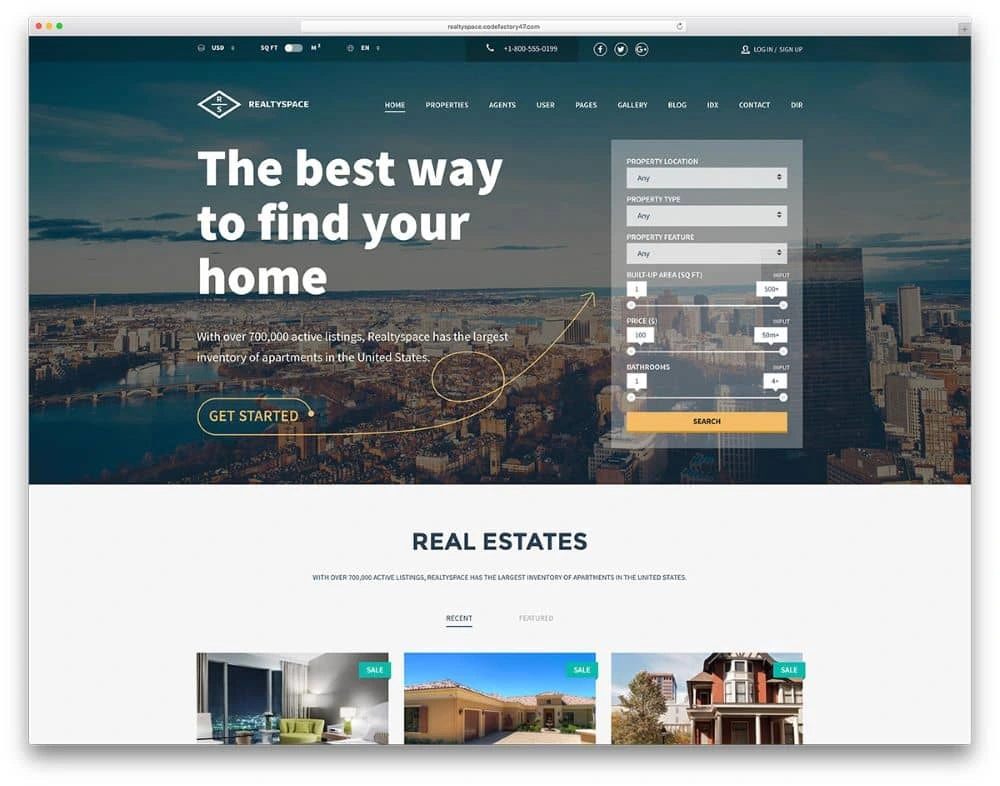
Source: Colorlib
If optimized properly, your website could be the foundation for attracting real estate leads online. It gives you the ability to provide value to your target market and help them engage with your brand.
Many real estate agents make mistakes in this area, and your website is not the place to describe your greatness in detail. Make your copy about how you’ll add value and better the lives of your customers.
An easy way to check whether your website is focused on your target market is to count how many times your site uses the word “we.” Customer-focused websites will use the word “you” more often.
3. Newsletter
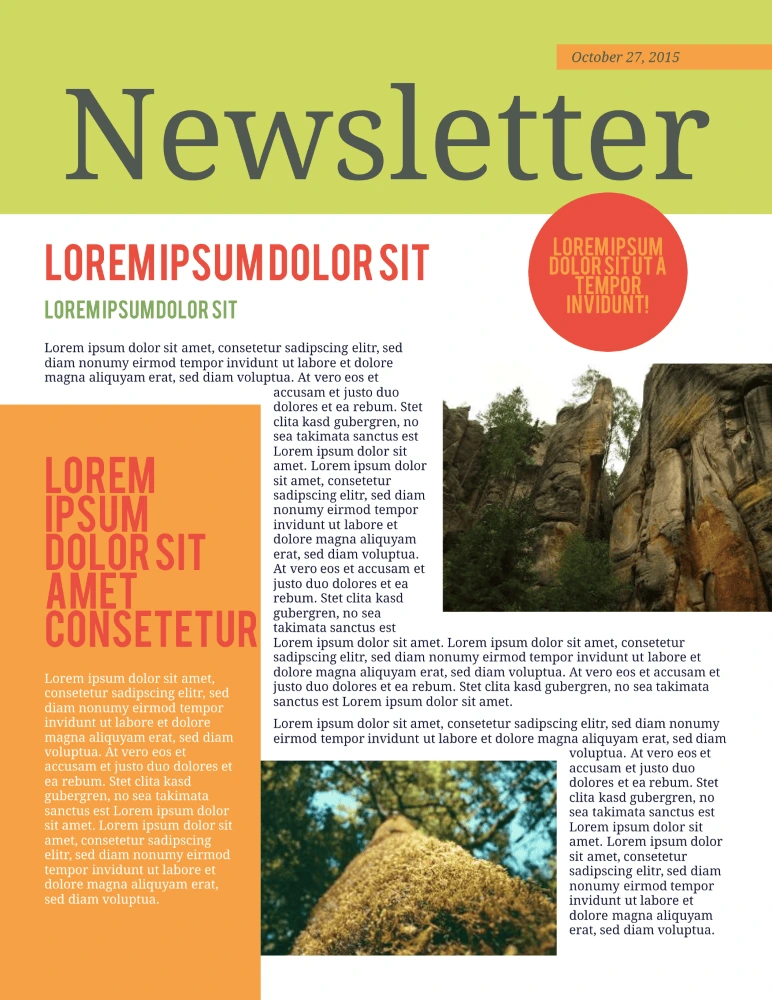
See more newsletter templates from Lucidpress
It’s always a good idea to keep your name top-of-mind, and a newsletter is a great way to do so. Newsletters can share real estate news, recent listings, and tips to deal with typical homeowner struggles—like preparing your house for the winter.
A newsletter is especially useful if your leads live in urban areas. Cities such as San Francisco, Los Angeles and Chicago are massive and busy, so it’s easy to miss out on events if you’re not paying attention. It’s also an excellent opportunity to inform subscribers about the latest news and events in their area.
Read more about newsletters: 13 best newsletter design ideas to inspire you
4. Blog
Blogging is one of the most popular and effective ways to generate leads online. But like any lead-generating tool, it has to provide great value to your target market. A blog post about the staff holiday party is not going to get the leads you want.
The best information to share with your target market is actionable. This could include topics like making a down payment, picking a lender, listing their home, and working with a real estate agent.
Free advice will grow your influence and make you a valuable resource—so when someone needs to sell or buy a house, they’ll think of you first.
Read more about blogging for real estate: How to use content marketing in real estate
5. SEO
The first page of search results has only ten slots. 33% of the people searching will click on the first result. 18% will go a step further and click on the second result. The further down the page you go, the fewer clicks there are—only 4.4% click on the sixth result.
That’s why every business wants to be on top. The lower you are, the harder it gets to attract your target market’s clicks.
The ideal SEO strategy is about finding the best keywords (and phrases) to target, then using them deliberately in your content to attract the customers you want. SEO powerhouse Moz has lots of free resources and tools to help you get started.
6. Video
If seeing is believing, then showing off the fantastic features of your properties is a surefire way to win converts—and there’s no better way to do that than with video.
Videos empower your potential clients to take a guided tour of your properties. They’ll be engaged by your content, but more importantly, they’ll be motivated to reach out for more information.
A video is far more than just a slick way to show off a property. On average, an online video converts 33% of leads. If you want a more captivating way to connect with your target market, video marketing is a great way to increase interest in your properties.
Read more about video marketing for real estate: How to create stellar videos for real estate listings
7. Influencer marketing
Connecting with others in your industry is always wise, and doing it online makes it easier than ever. You can share and amplify each other’s work through social media and comment on posts each of you publish.
Influencer marketing takes this one step further. It starts by figuring out who your target market is—specifically. Then, you can find influencers who are popular among the folks you want to target. By partnering with these influencers on advertising campaigns, you can reach wider audiences and attract more people to your brand.
Read more about influencer marketing in real estate: 5 influencer marketing strategies for real estate
8. Mobile optimization
Industry professionals often spend tons of time and money making sure their website is professional and easy to use… then forget to check how it looks on a smartphone or tablet.
Mobile search has surpassed desktop search, so it’s more important than ever that your website works with mobile devices. (Google is going as far as penalizing sites that haven’t created mobile-friendly layouts.)
Make the switch. Not just to protect your website from Google, but to impress customers who encounter your brand exclusively via mobile device. Aim for the same goals as your regular website: clear copy, attractive design and intuitive function.
Want to go even further with mobile? Read more about using mobile text messaging for real estate: 5 steps to build out your real estate mobile text messaging strategy
9. Referrals
When you start off as a real estate agent (or in any field, really), you won’t have a network. So, it’s up to you to build one.
As you begin to deal with customers, don’t forget to ask for referrals. Encourage them to share your name with others—make it easy and worthwhile for them to do so. Whether it’s to their friends, family or coworkers, advertising by word-of-mouth is powerful. People are more likely to follow recommendations from people they know than an anonymous review online.
10. Retargeting
Although we covered social media all the way at the beginning of this guide, we left out one element that deserves its own section: retargeting via Facebook ads.
Facebook ads are not a popular method of advertising in real estate circles, despite how high the ROI can be. Here, retargeting simply means that people who have shown interest in your brand will see your ad again. This “interest” is measured by actions such as reading your blog posts, clicking on one of your ads, or even signing up for your newsletter.
Your conversion rate will improve if you target people who want what you’re selling. People who are actively interacting with your brand are more likely to buy than those just scrolling through their feeds. Retargeting keeps your brand top-of-mind for the folks who matter most.
Key takeaway
Leads don’t just magically appear in your inbox. You need a strong lead-generating strategy that helps you cultivate interest in your brand and set you apart from the competition. These tips should get you on the right track to generating real estate leads online.
Hungry to hear about the best marketing practices for real estate? Hop over to our real estate marketing guide for more ideas & inspiration.
Social media has changed a lot over the last decade—and the way marketers manage social media channels has changed, too. Few marketers have the bandwidth to stay on social media all day, curating and sharing content as they go. Many of us have additional job responsibilities, and we have to be structured and deliberate about the time we dedicate to social.
Related: 6 effective social media strategies to increase brand awareness
Fortunately for us, there are lots of tools out there designed to make social media management easier and more efficient. From finding sharable content to scheduling posts, the 30 tools listed below can help you streamline and automate the tasks you can—so you have more time to spend on the ones you can’t.
What is social media automation?
Before jumping into the list and trying out the tools, let’s quickly clarify what we mean by automation. Social media automation is using software or tools to accomplish specific tasks on social media platforms without human intervention. Put simply, it means using a program to automate things like posting and sharing content on Facebook, Twitter, and other platforms.
30 best social media automation tools
Without further ado, let’s get to our list. You’ll find big players and small players here, with a variety of specialties and capabilities, so there’s something for everyone. The descriptions are short, just to give you a general idea of each tool’s primary strengths. If you want more info, give one a click and check out their website.
Our picks for the 30 best social media automation tools out there today are…
1. Buffer
One of the market leaders, this popular tool lets you schedule & publish upcoming posts across all of your social media accounts. It also offers excellent analytics on your campaigns.
2. Hootsuite
Hootsuite is another popular choice. You can use it to schedule your posts and monitor the competition. Using search streams, you can more easily build a community of followers.
3. Workflow
With Workflow, you can craft the ideal workflows (hence the name) so that the right content is always shared at the right time.
4. SocialPilot
The tool automates the process of scheduling content across various social media accounts. You can also learn more about your followers, so you can determine the right content to post.
5. IFTTT
An acronym that stands for “If this, then that,” this free tool lets you set up rules for how different tools, apps and social media platforms trigger one another. It’s a simple concept that’s hard to explain, so pop over to their website for details and examples.
6. Sendible
The tool is designed to help you schedule updates, reply to followers, create reports, and collaborate with others.
7. Later
Later is a powerful tool for Instagram scheduling that boasts over 600k customers. Unlike many social media tools, you can use this one to manage comments.
8. Tailwind
Tailwind is an automated scheduling and analytics tool that’s great for Pinterest. It will recommend the best times for you to post to reach your audience.
9. CoSchedule
This application helps you to schedule all your posts. In fact, you can schedule over 60 posts at once! You can also use it to lay out your social media calendar.
10. Post Planner
This simple tool helps you to find content and schedule posts for your social media accounts.
11. Iconosquare
Iconosquare arms you with personalized information about your social media accounts that will help you manage activities more efficiently.
12. Agorapulse
You can easily plan and schedule posts across your social networks with this tool, but it’s also useful for tracking performance.
13. Crowdfire
This automation tool helps you root out inactive Twitter followers. It’s also worth using if you want to discover the right cadence and content to share with your audience.
14. Socialert
Social media listening is made much easier when you use this tool. Again, it’s all about finding the best content for your audience and being part of conversations as they happen.
15. BuzzSumo
BuzzSumo is popular with content marketers because it’s great at finding trending topics. Results can be filtered based on location and domain. You can also find influencers here and start building relationships with them.
16. Scoop.it
With this tool, you can easily curate content from other sources and share in a way that reflects your brand’s personality and values. You can also use it to set up a smart social calendar.
17. Pocket
This “read later” tool lets you save content you find around the internet. The service is free, and you can access it anywhere, so you’ll never lose track of that one awesome article you found again.
18. Sprout Social
Designed to help small businesses use social media more effectively, this tool automates posting. It can also help you engage with an audience and monitor the competition.
19. Mention
You’ll never miss a conversation your brand is mentioned in when you use this tool. It’s also great for identifying influencers and monitoring keywords in real time.
20. TweetDeck
TweetDeck is an awesome free service for social media listening on Twitter. You can set up custom timelines to track brand names, usernames, hashtags, keywords and more.
21. SocialOomph
SocialOomph makes it really easy to manage your Twitter accounts. Effortlessly schedule tweets, track keywords, and more.
22. MeetEdgar
MeetEdgar is a fascinating take on social media automation. You can build a library of content you’d like to share across different platforms, and Meet Edgar will automatically schedule it for you—including repeat posts. It can even write variations of your posts to keep things fresh.
23. Everypost
Everypost is perfect for brands who want to schedule and share visual content on social media.
24. Facebook Pages Manager
No surprise here, this app helps you manage your Facebook pages effectively. You can get insights on traffic, clicks and views from its main menu.
25. Zoho Social
With Zoho Social, you can schedule as many posts as you like and monitor keywords & trends. It’s great for teams who collaborate on social media.
26. SocialFlow
This is one of the best tools for publishers, because it replaces arbitrary scheduling with data-driven scheduling, so your audience is engaging with you in real time.
27. Social Studio
Social Studio by Salesforce offers marketers a range of features such as publishing posts across various platforms, social media listening, and managing marketing commands.
28. Sprinklr
This tool helps you to achieve end-to-end social media marketing management. Data is unified across platforms, and publishing is automated.
29. DrumUp
DrumUp is an interesting tool that helps you discover and share meaningful content with your audience.
30. Kontentino
The last tool on our list provides you with easy, flexible workflow management. Content is easy to schedule, share and modify.
Bonus: Lucidpress
That’s right—it’s yours truly! If you’ve used Lucidpress before, you might be asking yourself: Why are we including ourselves in this list?
The answer: because Lucidpress has a host of new features that actually make it easier than ever to streamline social media for brands.
Everyone knows we offer some of the best free social media templates around—but have you ever considered creating your own branded templates with certain elements locked down?
Imagine if, instead of starting with a blank slate, you could always start with a perfectly sized template that uses your brand’s colors, fonts & logos. That would save a lot of time, right?
Don’t forget, you can share your Lucidpress designs straight to Facebook, Twitter and Buffer… without ever leaving the tool. That makes it a one-stop shop for creating beautifully branded social media posts and sharing them to your platforms of choice.
Key takeaway
Social media automation helps you discover and share the right content at the right time. Automation tools can also help you analyze audience behavior, monitor conversations, keep an eye on competitors, and more. For the best results, consider your business’s goals with social media (and your preferred budget) before selecting a tool.
Ready to drive more leads and engagement with social media? Grab a copy of our free ebook: How to adapt your brand to social media
Social media can help real estate agents find a wide audience, in the right area and at the right time.
In fact, according to the National Association of REALTORS 77% of real estate agents use social media. Facebook is by far the most popular platform in real estate, followed by LinkedIn and Instagram.
Related: Real estate marketing guide
Even with limited resources, savvy real estate agents can build meaningful relationships and earn more clients with social media.
How do you do it?
The sheer array of social media platforms and real estate marketing techniques seem overwhelming. Here are seven and a half practical tips to get you started in no time.
Social media for real estate tip #1: The basics
If you are already set up on social media, go ahead and skip ahead to the advanced tips below.
Facebook for real estate
To get started, set up a business page on Facebook. This is more professional than posting to a personal account and gives you access to useful business features such as page analytics and the ability to promote posts to your audience. Posts with images and video perform best on Facebook, so be sure to use compelling visuals with every post you create.
The Facebook algorithm favors posts that get a lot of engagement, so ask questions to drive comments or share content your followers will enjoy such as an upcoming local event, so they like and share it. If you’re just getting started and don’t have a large social media following yet, holding a contest to bring awareness of your real estate page is a great way to build up your follower count.
Instagram for real estate
Instagram is quickly becoming one of the most popular social media sites. As a visual platform, every post will need to be visually compelling. Use the caption that goes with the photo to provide additional details and include your contact information. A single Instagram post can be made up of a series of images, making it a great way to show photos of a new real estate listing.
LinkedIn for real estate
Update your personal profile and if you are running your own business, create a page for the business as well. LinkedIn provides a great opportunity to network with other real estate agents, connect with real estate brokerages and connect with current clients.
Social media for real estate tip #2: Start two-way conversations
A staggering 94% of millennial homebuyers are taking their search online. This creates incredible opportunities for real estate agents to connect with them there—but only if they truly understand their audience’s motivations.
It’s tempting for real estate agents to promote their business and new home listings relentlessly on social media. After all, isn’t that what those platforms are for?
Not exactly. For potential homebuyers, constant, in-your-face promotion has minimal appeal. If they wanted endless advertisements, they could just flip open a magazine or turn on the TV. Treating them this way shows a fundamental lack of understanding about your target audience.
The vast majority of potential homebuyers are searching for information. They have questions. If they’re considering buying for the first time, they’re probably intimidated, too.
Savvy real estate agents use social media to walk everyone through the process, creating stronger bonds than the constant sales pitch approach. Instead of just posting endless promotional content (a one-way broadcast), you open up two-way conversations. The audience becomes a key creator of the shared experience.
This takes on many forms. It might be searching Twitter hashtags and offering real estate advice to those in your local area. Tomorrow it might be hosting a Q&A session on Facebook Live. Next week it might be something as simple as asking a question in your newest listing photo caption on Instagram. Whenever you can, invite your audience to participate in the conversation.
Yes, you can still find opportunities to promote your real estate listings. But, a commitment to being relentlessly helpful builds trust and authentic relationships.
Social media for real estate tip #3: Choose your social media platforms wisely
Social media is fast-paced, chaotic, and changing constantly. It’s easy to get overwhelmed by the sheer number of platforms.
Real state agents new to social media might feel the pressure to “be everywhere.” Pressed for time already, they drive themselves crazy trying to maintain a presence on a dozen different accounts.
This approach actually leaves them worse off than before. Because they’ve spread themselves so thin, it’s impossible to get the traction needed to build an audience on any platform.
What could you do instead?
Start by taking a deep breath. Acknowledge there are tons of platforms out there—and a lot to learn. And accept that you’ll see the best results for your real estate business by focusing on just a few right now. Begin the journey with proven social networks like Facebook, Twitter and Instagram.
Which platforms deserve the majority of your focus? A lot depends on your audience. Beyond the overall popularity of the platform, consider where your target market spends their time online. You wouldn’t want to launch a Snapchat strategy when trying to sell retirement condos—the demographics there skew too young. If you’re selling commercial real estate, consider connecting with successful professionals and industry organizations on LinkedIn.
Do some preliminary research to pinpoint where your audience is most engaged. Other real estate agent’s and brokerages accounts can be a great place to start. Using those insights as a guide, narrow your focus to a few platforms as availability allows… which brings us to the next point.
Social media for real estate tip #4: Post consistently (and strategically)
A successful social media for real estate strategy is a lot like a successful relationship-building strategy in real life. You need consistent contact—and interactions that provide value and motivate people to keep coming back.
The goal: create enough interactions for your audience to get to know you as a real estate agent without overwhelming them to the point they tune you out.
This is a delicate balance to maintain, but the good news is it’s something you can always adjust as you go. Feedback from your networks (whether you’re gaining or losing followers, their engagement, etc.) will tell you if you’re headed in the right direction.
You can use social media software to schedule posts beforehand. This gives you the freedom to meet with clients, work open houses, and attend closings all while building your presence automatically. It’s easy to post multiple times a day this way.
Posting frequency is one thing, but you also have to consider the nature of the content itself. Most content breaks down into three different types:
- Time-sensitive/promotional. These posts advertise new properties on the market, open houses, or your brand in general. Think of listing photos, tweets urging prospects to give you a call, and virtual tours with Facebook livestreams or 360-degree photos.
- “Evergreen” how-to or informative. This content answers questions, shares tips, or finds alternative ways to provide value. It’s just as valuable a year from now as it is today. This could be decorating tips, a checklist to help you see how much house buyers could afford, or cool DIY renovation project ideas.
- Fun or entertaining. This content might not be directly related to real estate, but it’s a great way for you to showcase your personality. It might be a review of a new restaurant in town, a heads-up about traffic on the way home, or even those viral cat photos. Social media just gets prospects in the door. It’s your personality and expertise—real-life relationship skills—that will close the deal.
Understand the goal of each post you make, and mix things up to engage your audience and keep them coming back.
Finally, remember that there’s no need to create all this content yourself. Supplement your own efforts by sharing, retweeting or linking to other great content in the real estate industry. Your clients are a great content source—whether it’s sharing a quote from their testimonial or a photo of them toasting a new home.
Social media for real estate tip #5: Incorporate storytelling
Every great real estate agent knows how to tell a compelling story. Include that storytelling element in the social media content you create.
Some examples:
Talk about the neighborhood. When posting a new real estate listing, do more than talk about the price and features of the home. Create a compelling story by including details about the neighborhood. Help the potential buyer picture what it would be like to actually live in that home.
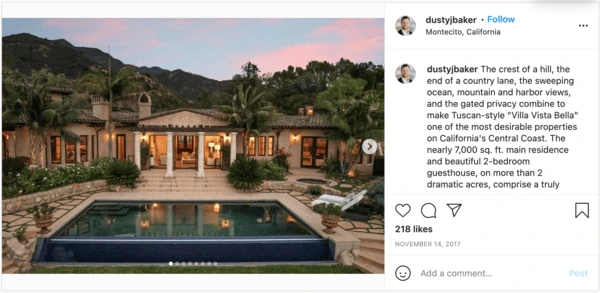
A post shared by Dusty Baker (@dustyjbaker) on Nov 14, 2017 at 10:46am PST
Include client testimonials. Ask happy customers if they’d be willing to create a video testimonial. Testimonials make compelling stories that help build trust with your audience.
Share milestones. On LinkedIn, share milestones of your real estate business. This could be anything from 10 years in business to updated branding or a new website.
Using storytelling in your social media campaigns will help drive greater engagement and build trust with your audience.
Social media for real estate tip #6: Use great, on-brand visuals
Social media has transformed the way realtors and agencies connect with potential buyers and clients. Because of the visual nature of house shopping, it’s easier than ever for people to go online and find examples of their dream homes.
Ideally, this should make real estate marketing faster and easier… but unfortunately, that’s not always the case. If you’re unfamiliar with Photoshop or other desktop publishing software, it can be difficult and time-consuming to create content specially for each social media site.
Instagram is a completely visual platform, which makes it perfect for marketing real estate. Photos are nice to have, but it can leave buyers confused as to what to do next—”Is this property for sale or just for show?” they might be wondering. By using this square photo collage, you can show off multiple views of the property and guide folks toward the next step: contacting you for a walkthrough or an offer.
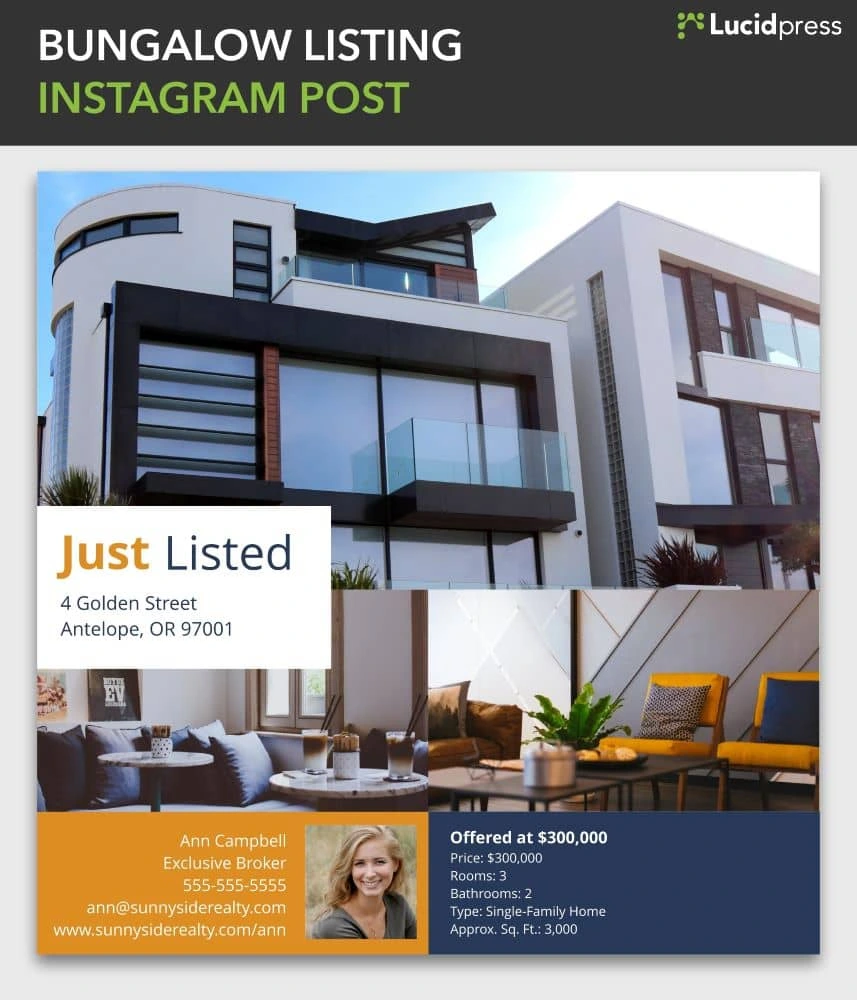
Speaking of visual platforms, Pinterest is a haven of gorgeous home ideas, which makes real estate a natural fit. Pinterest users build boards to house (heh) their pins, all of which come from various sources. It’s easy for your name or website to get lost in the shuffle—unless your images themselves are clearly branded. That’s what makes this perfectly sized Pinterest template a cut above the rest. The majority of space is reserved for eye candy, but all the important property details are right there, too.

When you want to get a new listing out fast, no platform is better than Twitter. Not only can you keep your followers in the know, you can also target new audiences with paid promotion to get the most mileage. Because things move so quickly on Twitter, it’s important to design posts that are easy to digest. This template is oriented horizontally; it’s compact and looks great on both desktop and mobile.
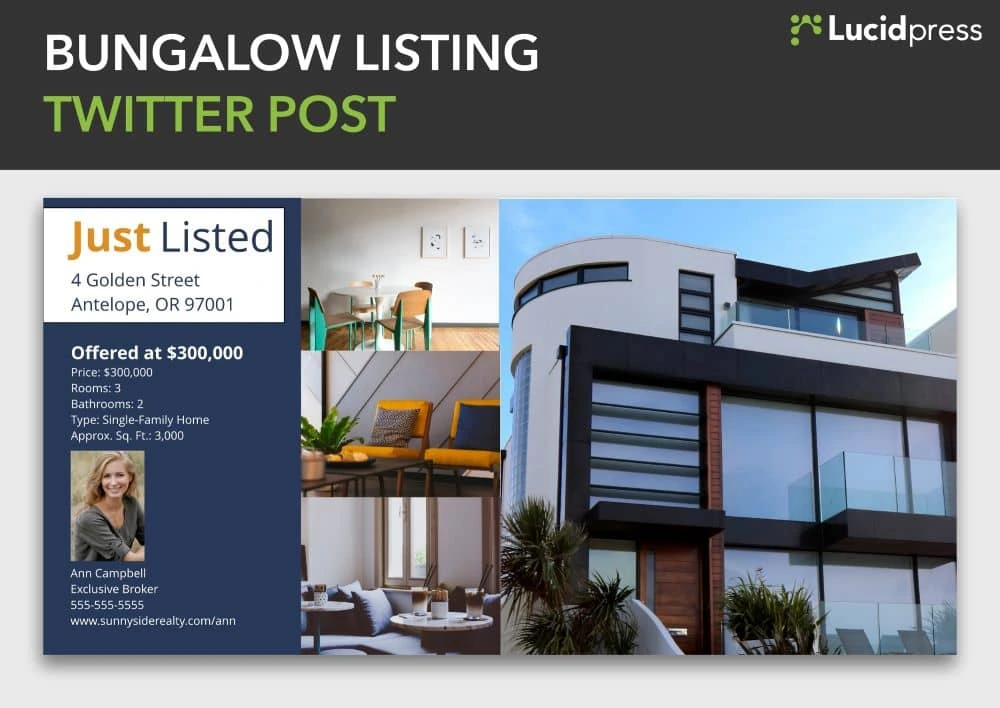
Social media for real estate tip #7: Remember your past clients
Social media is a great tool for realtors to build relationships and land clients. But, that’s only part of its appeal. It can also help maintain relationships you’ve already developed.
What happens when those closing papers are signed? Clients feel a rush of adrenaline, but after a few months, everyday life creeps back in. An incredible 70% of homeowners can’t even remember their real estate agent’s name one year after closing.
It’s a shame to have those relationships slip away after you’ve spent so much work building them. With a little social media love, it’s much easier to maintain them. That way, when clients are ready to move again or recommend a realtor to family or friends, you’ll be the first person who comes to mind.
How can you do this on social media?
Release a steady stream of that evergreen content we mentioned earlier. Brainstorm all the things you wish you knew when you moved into a home. Is it design inspiration? Checklists to get organized? Ways to prepare for the winter or save money on utility bills?
You can also broaden your content from real estate itself. Now that your client has moved, they’re living, working and integrating into the community. They might be interested in that new restaurant down the road. Or the best summer camps to send their kids. You can become their go-to source for all things local.
Social media for real estate tip #71/2: Measure and keep learning
You’re sending emails to clients, working open houses, and putting out yard signs. (Not to mention trying to keep up with your own personal life.)
You don’t have endless hours to pour into social media that isn’t paying off. How are your tweets performing compared with your Pinterest posts? Should you be posting on Facebook or focusing on Instagram?
These are the questions that can frustrate you to no end. Instincts might give you some indication, but measuring will let you know for sure.
Fortunately, it’s never been easier to collect data on social media performance. It’s easy to see which posts get the most engagement in terms of likes, retweets and comments. But, if you’re looking to see what’s really moving the needle in terms of sales, why not create unique landing pages for each platform?
A landing page simply directs visitors whenever they’re interested in contacting you, seeing a new listing, and so on. Tailoring them for each social media platform allows you to track where leads come from. You can also find out a lot more about each user’s interactions with your brand and their path to becoming a client.
Keep an eye out on which platforms, campaigns and topics perform best. As long as you keep tracking your analytics and tweaking your strategy, it will gradually get more effective. This optimization process never ends, but the payoff increases over time.
Over to you
Social media has become an essential piece in every realtor’s marketing toolkit. Thankfully, it doesn’t have to be overwhelming anymore. Apply the tips above while launching your real estate marketing strategy, and you’ll build an impressive audience, engage them, and bring in more business.
Kickstart your next social media campaign with our free templates for real estate.
There’s no denying it – Facebook isn’t the powerhouse of a social media platform it used to be back in the aughts. But while organic reach has declined over the years, don’t discount how valuable Facebook can be as a part of your social media marketing strategy.
As of 2023, Facebook has over 3.03 billion monthly active users. That means if you want to get eyes on your brand, Facebook is definitely a place to build a consistent presence.
Want some tips on building brand affinity on Facebook in 2023 and beyond? Keep reading!
How to build brand affinity on Facebook
1. Create captivating, on-brand creative
With so much competition already on Facebook, you want to be publishing content that not only catches peoples’ eye, but content that is clearly consistent with how your brand looks elsewhere. Using unique imagery and bright colors can be a good start, but only if that fits with the brand you’ve already curated.
For example, if you publish 20 Facebook ads that all use different styles and colors, no one is going to be able to recognize your brand.
Instead, stick to your brand colors whenever possible and always include your logo in the ad. You should also use the same principal font that’s on your site, and never use more than two fonts in one ad.
Here’s a great example of what to do vs. what not to do:
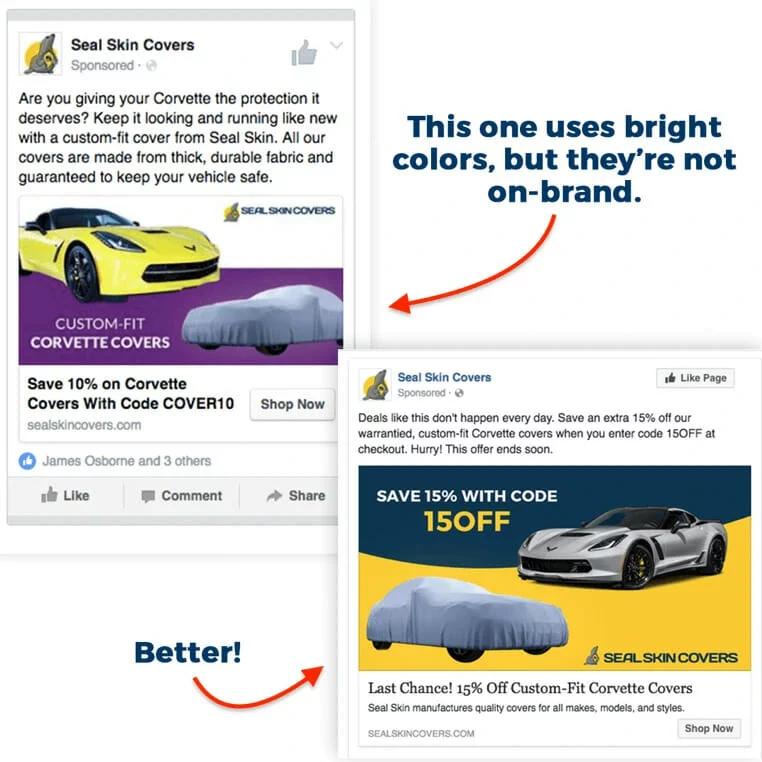
2. Use targeting filters and “Lookalike audiences” to find new fans
While remarketing campaigns are like shooting a fish in a barrel, finding new consumers who will have a genuine interest in your brand is a far more challenging task. Luckily, Facebook has a variety of unique targeting features that can help you refine your audience. Think about the demographics, behaviors and interests of your ideal customer and use that information to narrow your selection. For example, if you own a bridal shop and want to increase your wedding dress sales, you could target people who recently became engaged.
Facebook also has a unique feature called Lookalike Audiences. Think of it like a matchmaking service for brands looking to grow their audiences. To use this tool, you’ll want to create or import a custom audience that fits your ideal consumer.
Then, Facebook will work its magic and identify new customers who are likely to be interested in your brand based on that custom audience. This can be an incredibly valuable tool, and can help you save on ad spend and spend less time searching for quality leads.
3. Establish a brand voice—and stick with it
One of the most important elements of building brand affinity (no matter what platform you’re using) is sticking to your brand voice. For example, if you own a mortgage firm and your brand voice is authoritative and professorial, then you don’t want to run ads that are filled with over-the-top puns and jokes.
We recommend being consistent with your terminology as well. If your e-commerce company refers to buy-one-get-one-free sales as “BOGO,” this should be a consistent term in all your ads.
The more people you have working on copy for your Facebook ads, the trickier it can be to establish a consistent brand voice. Creating a brand style guide with rules on tone, voice, and POV can help.
4. Advertise free content, too
Everyone likes free stuff – especially if they might not be ready to fully commit yet. Instead of focusing exclusively on selling, get creative with free content, whether that’s free information (whitepapers, newsletters, ebooks, etc), or free products.
Athleisure brand Girlfriend Collective used this tactic to their advantage when they first launched. To drum up word-of-mouth and interest in their sustainably-made leggings, they offered their audience free leggings for a limited time. The result? They received over 10,000 orders on the first day of this freebie campaign. Not too shabby, eh?

5. Follow the right image sizing guidelines
Visuals are everything, and in the world of social media, they’re often the first things your audience notices. As such, you want to make sure your images are the right dimensions.
Here’s a handy guide to Facebook image sizing.
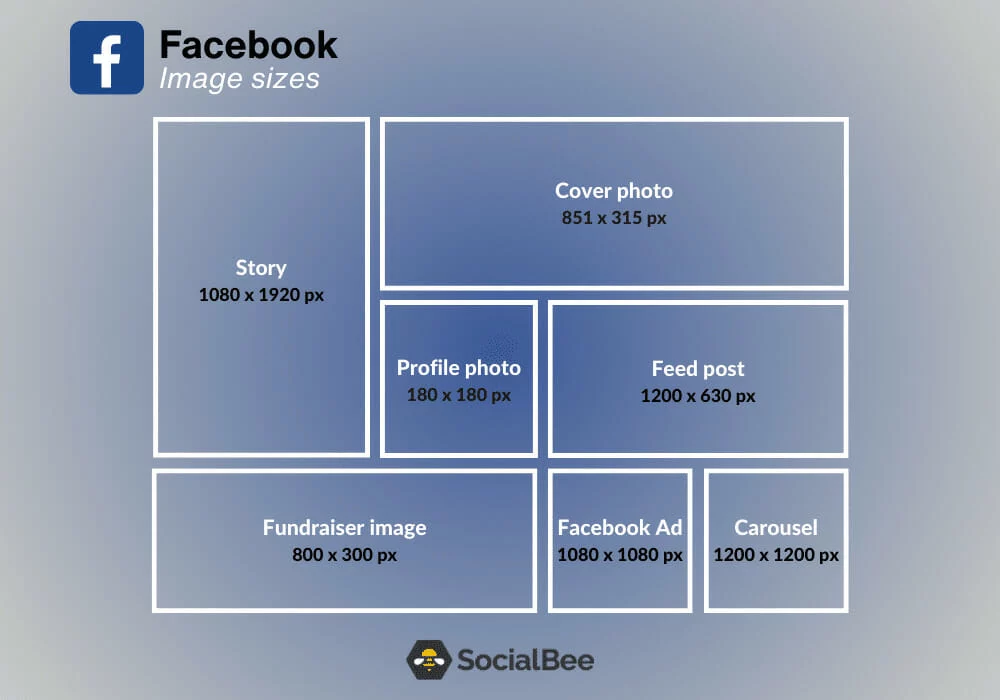
When it comes to your profile page in particular, making sure your imagery is visible both on desktop and mobile devices is crucial. While the ideal Facebook cover photo size is 820 pixels wide by 360 pixels tall, if you use an image that size, the edges will be cropped on mobile (and the top and bottom will be cropped on a computer). To avoid losing important elements of your cover photo, keep the most important details 90 pixels from the right and left sides and 12 pixels from the top and bottom edges – like this:

Want to streamline your Facebook marketing process? Check out our free library of customizable Facebook ad, cover photo, and post templates and get publishing today!